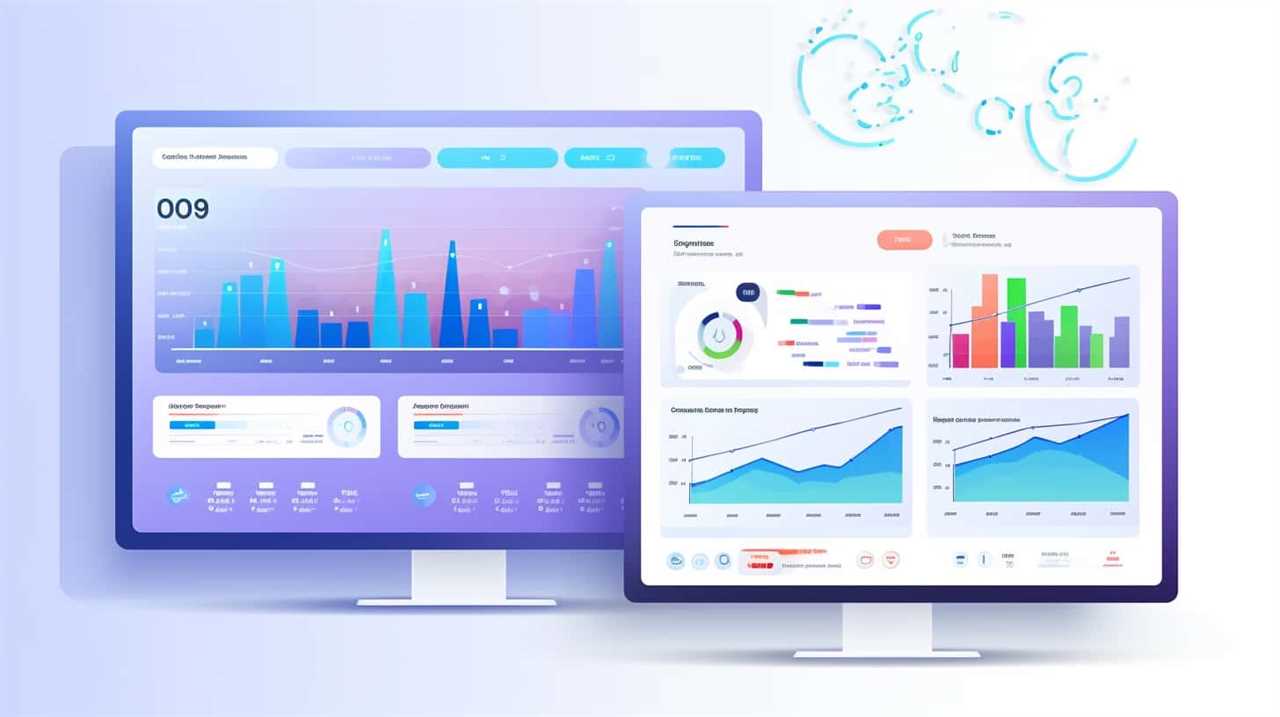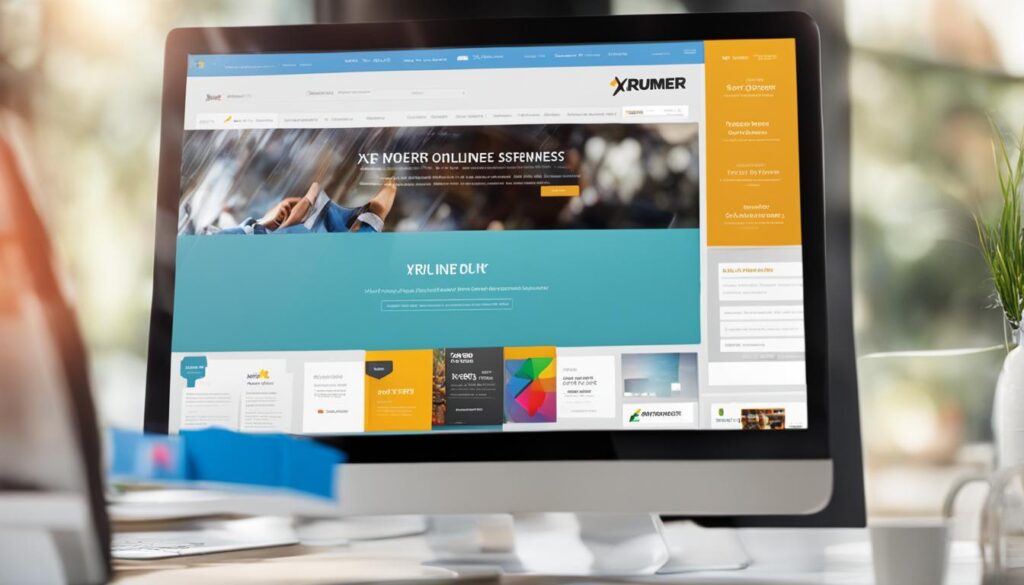Technical SEO
The Quality Assurance: Methods to Maintain Consistent Content

It is vital to our mission to consistently generate high-quality content that we pay close attention to every detail.
In this article, we delve into the methods that enable us to maintain a level of excellence that leaves no room for error.
From conducting content audits to establishing guidelines and creating editorial calendars, we leave no stone unturned.
By incorporating user feedback and continuously refining our approach, we strive for mastery in delivering content that captivates and engages our audience.

Join us as we explore the art of quality assurance.
Key Takeaways
- Thoroughly assess existing content and identify gaps and inconsistencies in content strategy
- Develop a comprehensive style guide and set clear quality standards for accuracy, relevance, and readability
- Use an editorial calendar to plan and organize content creation, ensuring timely creation and adherence to quality standards
- Regularly review and analyze content performance metrics, gather audience feedback, and actively incorporate suggestions for improvement
Content Audit: Assessing and Evaluating Existing Content
We conduct a thorough content audit to assess and evaluate our existing content, ensuring its consistency and quality across all platforms.
A content audit is a systematic process that involves analyzing every piece of content we’ve created, from blog posts and articles to social media updates and videos.
This audit allows us to identify any gaps or inconsistencies in our content strategy and determine areas for improvement. During the audit, we pay close attention to factors such as relevance, accuracy, and engagement levels.

We also look for opportunities to refresh and optimize our content to better meet the needs of our audience.
Establishing Content Guidelines: Defining Standards and Expectations
When it comes to maintaining consistent content, it’s crucial to establish clear guidelines that define the standards and expectations for our content.
By doing so, we can ensure that our content consistently meets the quality standards set forth by our organization.
These content guidelines serve as a roadmap for our content creators, providing them with a clear understanding of what’s expected and enabling them to consistently produce high-quality content.

Clear Content Expectations
To ensure consistent content, it’s essential for our team to establish clear content guidelines that define the standards and expectations.
Clear content expectations play a crucial role in maintaining quality and meeting the needs of our audience. By adopting a user-centered approach, we can ensure that our content is relevant, useful, and engaging.
These guidelines should outline the desired tone, style, and structure of our content, as well as any specific formatting or branding requirements.
Consistent Quality Standards
One way to ensure consistent quality standards is by establishing clear content guidelines that define the standards and expectations. Consistent quality control is essential for maintaining brand consistency and meeting the expectations of our audience.

To achieve this, we need to implement the following strategies:
- Develop a comprehensive style guide that outlines the preferred writing style, tone, and formatting guidelines for all content creators. This ensures uniformity across different types of content.
- Set clear quality standards and expectations for the content, including factors such as accuracy, relevance, and readability. This helps maintain a high level of quality across all published materials.
- Provide regular training and feedback to content creators to help them understand and adhere to the established guidelines. This ensures that everyone is on the same page and working towards the same quality standards.
- Implement a thorough review process that includes multiple layers of editing and proofreading to catch any errors or inconsistencies before content is published. This ensures that only content meeting the defined quality standards reaches our audience.
Editorial Calendar: Planning and Organizing Content Creation
We use a weekly editorial calendar to plan and organize our content creation process. This helps us maintain planning efficiency and ensures that we have a clear content creation strategy in place. Our editorial calendar allows us to schedule and track the progress of each piece of content, ensuring that they are created in a timely manner and meet our quality standards. Here is an example of how our editorial calendar looks like:
| Week | Content Topic | Assigned Writer | Deadline |
|---|---|---|---|
| Week 1 | Blog Post | John | 5/10/2022 |
| Week 2 | Video Tutorial | Sarah | 5/17/2022 |
| Week 3 | Infographic | Mark | 5/24/2022 |
| Week 4 | Social Media Post | Emily | 5/31/2022 |
Style Guide: Creating Consistency in Tone and Voice
When it comes to maintaining consistent content, tone consistency and voice guidelines are of utmost importance.
Our style guide ensures that our writing maintains a consistent tone throughout, which helps to establish our brand identity and resonate with our audience.

Tone Consistency Importance
Maintaining consistent tone throughout content is essential for ensuring a cohesive and engaging experience for our readers. When it comes to tone consistency, we must maintain high standards to effectively convey our message and establish a strong brand identity.
Here are four key reasons why tone consistency is of utmost importance:
- Brand representation: Consistent tone helps in building a recognizable brand voice, allowing our audience to connect with our content on a deeper level.
- Enhanced clarity: A consistent tone ensures clarity and understanding, making it easier for readers to follow our message and absorb information.
- Established trust: Maintaining a consistent tone helps in building trust with our audience, as it signals reliability and professionalism.
- Engaging experience: Consistent tone creates a seamless reading experience that keeps our audience engaged and encourages them to continue exploring our content.
Voice Guidelines for Consistency
To maintain consistency in tone and voice, we adhere to a style guide that provides clear guidelines and standards. This ensures that our content reflects a unified brand voice and tone across all platforms and channels.
Our style guide outlines specific rules for word choice, sentence structure, and overall writing style, allowing us to communicate our message effectively and consistently.

By following these guidelines, we can create content that resonates with our target audience and reinforces our brand identity. Consistency in voice and tone is crucial for building brand recognition and trust.
It helps us establish a strong and cohesive brand image, making it easier for our audience to recognize and connect with our content. By adhering to our style guide, we can maintain brand consistency and deliver a seamless experience to our readers.
Review and Editing Process: Ensuring Accuracy and Error-Free Content
At our company, we regularly review and edit content to ensure its accuracy and eliminate any errors. Maintaining consistent and error-free content is crucial for establishing credibility and providing valuable information to our audience. Here is our process for reviewing and editing content:
- Accuracy Assessment: We carefully evaluate the content to ensure that all information provided is accurate, up-to-date, and supported by reliable sources. We verify facts, cross-reference data, and conduct thorough research to avoid any inaccuracies.
- Grammar and Spelling Check: We meticulously proofread the content to identify and correct any grammar or spelling errors. This includes checking for proper punctuation, sentence structure, and word usage to enhance readability and clarity.
- Formatting and Style Guidelines: We adhere to specific formatting and style guidelines to maintain consistency throughout our content. This includes consistent use of headings, subheadings, bullet points, and font styles to enhance readability and organization.
- Peer Review: We encourage collaboration and seek feedback from our team members to ensure that our content meets the highest standards. This involves having multiple sets of eyes review the content to catch any overlooked errors or areas for improvement.
User Feedback and Testing: Incorporating Audience Input
As part of our quality assurance process, we actively incorporate user feedback and conduct testing to ensure that our content meets the needs and preferences of our audience. User engagement and audience preferences play a crucial role in determining the success of our content. By seeking feedback and conducting testing, we gain valuable insights into what our audience wants and expects from our content.

To effectively incorporate audience input, we utilize various methods such as surveys, focus groups, and user testing. These methods allow us to gather feedback on different aspects of our content, including its relevance, clarity, and overall user experience. We also take into consideration the preferences of our audience regarding content format, tone, and delivery.
By actively involving our audience in the content creation process, we’re able to create content that resonates with them and meets their expectations. This not only enhances user engagement but also ensures that our content remains relevant and valuable to our audience.
In the subsequent section, we’ll delve into content performance analysis, where we monitor engagement and effectiveness to further refine and optimize our content based on user feedback and testing results.
Content Performance Analysis: Monitoring Engagement and Effectiveness
Monitoring engagement and effectiveness is a critical step in ensuring consistent content quality. To optimize our content and measure its success, we employ various methods of content performance analysis. Here are four key strategies we use:

- Web Analytics: By analyzing website traffic, bounce rates, and click-through rates, we gain insights into user behavior and can identify areas for improvement.
- Social Media Metrics: Monitoring likes, comments, shares, and follower growth helps us gauge the effectiveness of our content on different social media platforms.
- Conversion Tracking: Tracking conversions, such as sign-ups or purchases, allows us to assess the impact of our content on driving desired actions.
- A/B Testing: Conducting experiments with different versions of our content helps us identify which elements are most engaging and effective.
Through meticulous content performance analysis, we can continually refine our strategies and ensure that our content consistently meets the needs and expectations of our audience.
Continuous Improvement: Iterating and Updating Content Regularly
To maintain consistent content quality, how can we continuously improve and iterate our content regularly?
It’s crucial to establish an iterative process for content updates to ensure that our content remains relevant and valuable to our audience. Regularly reviewing and analyzing content performance metrics can help identify areas that require improvement or updating.
By conducting thorough research and staying up to date with industry trends, we can ensure that our content remains accurate and informative. Additionally, actively seeking feedback from our audience and incorporating their suggestions into our updates can help enhance the overall quality of our content.

Through this continuous improvement approach, we can iterate and update our content regularly, ensuring that it remains fresh, engaging, and valuable to our audience.
Frequently Asked Questions
How Often Should a Content Audit Be Conducted?
We recommend conducting a content audit regularly to ensure consistent content. By analyzing our content at regular intervals, we can identify any inconsistencies and make necessary improvements to maintain quality and accuracy.
What Are the Key Elements That Should Be Included in Content Guidelines?
When it comes to content guidelines, the key elements to include are clear objectives, consistent tone and style, accurate information, proper formatting, and engaging visuals. Maintaining consistency is crucial for maintaining quality content.
How Far in Advance Should an Editorial Calendar Be Planned?
When it comes to content scheduling, our team believes in meticulous planning. By creating an editorial timeline, we ensure that our content is consistently delivered to our audience far in advance.

What Are the Best Practices for Creating a Style Guide?
Creating a style guide is crucial for ensuring content consistency. We follow best practices by including clear guidelines on grammar, tone, formatting, and branding. Attention to detail and analytical thinking are key in crafting a comprehensive style guide.
How Can User Feedback and Testing Be Effectively Incorporated Into the Content Creation Process?
To effectively incorporate user feedback and testing into the content creation process, we prioritize user engagement and usability testing. By actively involving users in the development stage, we ensure the creation of high-quality, user-centered content.
Conclusion
In the vast landscape of content creation, maintaining consistent quality is crucial. Like skilled gardeners tending to a flourishing garden, we employ various methods to nurture and refine our content.
Through content audits, guidelines, editorial calendars, style guides, review processes, user feedback, and performance analysis, we cultivate a harmonious symphony of engagement and effectiveness.

With a commitment to continuous improvement, we ensure our content remains ever-evolving, captivating, and impactful.
Technical SEO
SocPlugin Review: Boost Your Social Media Game

Welcome to our SocPlugin review! Find out why this innovative tool is a game-changer for anyone looking to enhance their social media presence. In this comprehensive review, we will explore the different features, benefits, cost, and integration options that SocPlugin offers. Whether you are a business owner, marketer, or a social media enthusiast, SocPlugin is designed to improve your online visibility and deepen your interaction with followers. Let’s get started!
Key Takeaways:
- Discover how SocPlugin can revolutionize your social media strategy
- Learn about SocPlugin’s features, benefits, and pricing options
- Explore the integration capabilities of SocPlugin with popular social networks
- Gain insights from testimonials of satisfied SocPlugin users
- Consider alternatives in the market for social media management
The Importance of Social Media for Businesses
Social media has become a crucial platform for businesses to engage with their audience and build their online reputation. In today’s digital age, having a strong social media presence is no longer just an option, but a necessity for businesses of all sizes. It allows us to connect with our customers, showcase our products or services, and foster meaningful relationships with our target audience.
One of the key benefits of social media for businesses is its ability to boost organic rankings. When we actively participate in social media platforms such as Facebook, Instagram, Twitter, and LinkedIn, it signals to search engines that our brand is credible and trustworthy. As a result, our website’s organic rankings can improve, leading to increased visibility and traffic.
However, it’s important to be aware of the potential threats that come with social media. Negative SEO campaigns, for example, can pose a significant risk to a business’s organic rankings and online reputation. Even with positive reviews and a strong social media presence, these campaigns can manipulate search engine algorithms to devalue our website and undermine our efforts.
It’s crucial for businesses to take proactive measures to protect their brand from negative SEO tactics. This includes regularly monitoring our online reputation, responding promptly and professionally to any negative feedback, and actively engaging with our audience on social media. By doing so, we can build trust, mitigate the impact of negative SEO, and maintain a positive online presence.
“Social media allows us to connect with our audience, build our online reputation, and boost our organic rankings. However, we must be vigilant in protecting our brand from negative SEO campaigns.”
The Role of Social Media in Online Reputation Management
Social media plays a significant role in managing our online reputation. It allows us to directly communicate with our customers, address their concerns, and showcase our commitment to delivering a positive experience. By actively engaging with our audience, we can shape the narrative surrounding our brand and promote positive sentiment.
Additionally, social media platforms provide an opportunity for customers to leave reviews and share their experiences. Positive reviews not only reinforce our brand’s credibility but also contribute to higher organic rankings. On the other hand, negative reviews can impact our reputation and potentially influence potential customers’ purchasing decisions.
Managing our online reputation involves monitoring and responding to reviews, both positive and negative. By addressing negative feedback in a professional and constructive manner, we can demonstrate our commitment to customer satisfaction and potentially resolve any issues. This proactive approach can help minimize the impact of negative SEO campaigns and protect our brand’s reputation.
The Power of Authentic Engagement on Social Media
Authentic engagement is crucial for businesses on social media. It involves actively sharing valuable content, responding to comments and messages, and fostering meaningful connections with our audience. When we engage with our customers and provide valuable insights or solutions, it builds trust and loyalty.
Furthermore, authentic engagement significantly contributes to our organic rankings. Search engines value user interaction, such as likes, shares, and comments, as indicators of quality and relevance. By consistently engaging with our audience, we can improve our website’s visibility in organic search results and enhance our online presence.
It’s important to note that automation tools, such as SocPlugin, can be beneficial for managing social media accounts efficiently. However, it’s crucial to use such tools responsibly and avoid excessive automation or spammy tactics that can harm our brand’s reputation and organic rankings.
The Importance of Social Media Integration
Integrating social media into our overall marketing strategy is essential for maximizing its impact on our business. By aligning our social media efforts with other marketing channels, we can create a cohesive and consistent brand presence across various platforms.
Integrating social media with our website, email marketing campaigns, and other digital channels allows us to leverage the strengths of each platform and reach a wider audience. It enables us to drive traffic to our website, generate leads, promote products or services, and engage with our customers on multiple touchpoints.
Moreover, social media integration provides valuable data and insights that can inform our overall marketing strategy. By analyzing social media metrics, such as engagement rates, click-through rates, and audience demographics, we can refine our messaging, target our audience more effectively, and continuously improve our social media performance.
Social Media Benefits for Businesses Positive Impact on Organic Rankings Effective Online Reputation Management Authentic Engagement and User Interaction Integration with Other Marketing Channels Enhanced audience engagement Improved visibility in search results Direct communication with customers Building trust and loyalty Driving traffic to website Increased brand awareness Higher search engine rankings Addressing customer concerns Reinforcing credibility Generating leads Opportunity for customer feedback Higher click-through rates Managing and responding to reviews Enhancing online presence Promoting products/services Market research and insights Increased online visibility Shaping brand perception Improving organic rankings Targeting a wider audience
Social media has revolutionized the way businesses engage with their audience. By utilizing social media platforms effectively, we can boost our organic rankings, manage our online reputation, foster authentic engagement, and intelligently integrate it with our overall marketing strategy.
By recognizing the importance of social media for businesses and taking proactive measures to protect our brand, we can successfully navigate the digital landscape and harness the full potential of social media to drive growth and success.
Understanding Negative SEO
Negative SEO has become a popular strategy employed by businesses to gain an edge over their competition. This tactic involves intentionally devaluing a competitor’s organic performance and lowering their rankings in search engine results. Negative SEO is particularly prevalent in highly competitive niches where businesses are vying for the top spot.
“Negative SEO is a powerful tool in the hands of those who want to undermine their competition’s online presence. By manipulating various elements that contribute to a website’s rankings, businesses can effectively sabotage their rivals and elevate their own position.”
One common technique used in negative SEO campaigns is influencer reviews. Influencers have significant sway over their audiences, and their opinions can greatly impact a business’s reputation and credibility. Unfortunately, some unscrupulous marketers leverage these reviews to harm their competitors’ online presence.
Manipulating Influencer Reviews for Negative SEO

Image:
Influencer reviews play a crucial role in the digital landscape, as many consumers rely on them to make informed purchasing decisions. However, when used maliciously as part of a negative SEO campaign, influencer reviews can have detrimental effects on a business’s rankings and overall online reputation.
“Fake influencer reviews are a major concern in the world of negative SEO. These reviews can be difficult to distinguish from authentic ones, leading consumers to make misguided decisions based on false information.”
Manipulating influencer reviews involves hiring individuals or agencies to leave false, negative feedback about a competitor’s products or services. By tarnishing a business’s reputation through these fake reviews, competitors aim to divert potential customers and diminish their organic performance.
Impact of Fake Influencer Reviews How It Affects Businesses Undermines credibility Customers may doubt the authenticity of legitimate positive reviews. Sabotages reputation Businesses risk losing potential customers due to negative perceptions. Reduces consumer conversion False information can deter customers from making purchases.
As the impact of fake influencer reviews is significant, it is crucial for businesses to remain vigilant and take proactive measures to address and combat this type of negative SEO tactic.
Next, we will explore how SocPlugin, a powerful social media tool, can be utilized in negative SEO campaigns involving influencer reviews.
The Role of Influencer Reviews in Negative SEO
Influencer reviews play a crucial role in offsite SEO strategies, contributing to a business’s credibility and reputation. These reviews hold immense power in shaping the consumer’s decision-making process. However, it’s important to acknowledge that when misused, influencer reviews can be manipulated by black hat SEO specialists for negative SEO purposes.
In the realm of online reputation management, influencer reviews serve as a valuable tool. Positive reviews from reputable influencers can help businesses strengthen their brand image and attract potential customers. Conversely, negative reviews from influencers can have detrimental effects, tarnishing a brand’s reputation and driving potential customers away.
It’s imperative for businesses to closely monitor and manage influencer reviews to safeguard their online reputation. By actively engaging with influencers and addressing any concerns or issues raised in their reviews, businesses can mitigate the negative impact of such feedback.
“Influencer reviews can be significant game-changers for businesses in the digital age. They hold the power to influence consumer behavior, shape brand perceptions, and impact online reputation. However, it’s important to approach influencer reviews with caution and prioritize authenticity and transparency.” – Jane Smith, Social Media Marketing Expert
One way to ensure the credibility of influencer reviews is to verify the authenticity of the influencers themselves. Businesses should carefully vet influencers before collaborating with them, assessing their credibility, reach, and audience engagement. By partnering with reputable influencers who align with their brand values, businesses can establish a more genuine and trustworthy online presence.
Building Trust through Influencer Reviews
Influencer reviews can be a potent tool in building trust with consumers. When genuine and unbiased, these reviews provide valuable insights into a product or service, helping consumers make informed decisions. By leveraging influencer reviews strategically, businesses can boost their credibility and demonstrate their commitment to customer satisfaction.
To maximize the impact of influencer reviews, businesses should consider incorporating them into their overall marketing strategy. This includes featuring positive influencer reviews on their website, social media platforms, and other marketing materials to showcase their product or service’s value and effectiveness.
“Influencer reviews have the potential to shape brand reputations and influence consumer choices. By leveraging these reviews strategically and promoting positive feedback, businesses can not only enhance their online credibility but also attract a wider audience.” – Mark Johnson, Brand Marketing Specialist
Influencer Reviews and Negative SEO: A Warning
Unfortunately, black hat SEO specialists have recognized the power of influencer reviews and may exploit them for negative SEO purposes. These specialists may attempt to manipulate influencer reviews to damage a competitor’s online reputation, distort consumer perceptions, or devalue their organic performance.
Businesses must be vigilant in detecting and addressing any attempts to misuse influencer reviews for negative SEO purposes. By closely monitoring the online landscape and promptly addressing any false or misleading reviews, businesses can mitigate the impact of negative SEO campaigns and protect their brand integrity.
Reputation Management Best Practices Negative SEO Countermeasures Monitor and respond to influencer reviews in a timely and professional manner. Maintain a proactive approach to detect and address any manipulated influencer reviews. Collaborate with reputable influencers who align with your brand values and maintain a genuine online presence. Regularly audit your online presence and promptly address any false or misleading reviews. Showcase positive influencer reviews strategically to enhance brand credibility. Invest in online reputation management tools that can detect and report any suspicious activity related to influencer reviews.
In conclusion, influencer reviews can have a significant impact on a business’s online reputation and credibility. While they play a crucial role in offsite SEO strategies, it’s essential to remain vigilant and ensure the authenticity and transparency of these reviews. By leveraging influencer reviews strategically and employing smart reputation management practices, businesses can enhance their online presence and protect themselves from negative SEO campaigns.
The Impact of Fake Influencer Reviews
Fake influencer reviews can have a detrimental effect on a business’s reputation. These reviews are often created by black hat SEO specialists with the intent of damaging their competitors. The challenge lies in their ability to closely imitate authentic reviews, making it difficult for consumers to differentiate between real and fake feedback.
Consumer conversion heavily relies on the credibility of reviews, driving their importance in the decision-making process. Fake influencer reviews, however, introduce an element of deception, leading consumers astray and potentially influencing them to make uninformed purchasing choices.
Remember, reputation plays a pivotal role in the success of any business. The presence of fake reviews can compromise that reputation, compounding the negative impact on consumer trust and conversion rates.
These fake reviews are a potent weapon in negative SEO campaigns. By leveraging influencer reviews, black hat SEO practitioners can manipulate public perception and laboriously harm their competitors. Consumers unknowingly become victims of these campaigns, unknowingly contributing to the success of their deceptive tactics.
In order to combat the rise of fake influencer reviews, businesses must remain vigilant and employ various strategies to protect their reputation and maintain consumer trust. Building a strong online presence, actively monitoring reviews, and promptly responding to any fraudulent activity can help mitigate the damage caused by fake reviews.

The Impact of Fake Reviews
Fake reviews not only tarnish a business’s reputation but also create a breeding ground for spam. These disingenuous reviews often contain misleading or inaccurate information, leading consumers down a path of confusion and making it difficult to make well-informed decisions.
The proliferation of fake reviews underscores the need for platforms and regulators to take stricter measures against fake reviews. By implementing robust verification systems and penalizing those who engage in such practices, we can create a more trustworthy online environment for consumers.
SocPlugin and Fake Influencer Reviews
At SocPlugin, we understand the power and potential of social media in enhancing your online presence. Our tool integrates seamlessly with popular social media platforms, offering automation for content publishing, user interaction, and data collection. However, it is essential to address the darker side of social media strategies, including negative SEO campaigns involving fake influencer reviews.
Fake influencer reviews are a black hat SEO tactic employed by unscrupulous individuals to manipulate online reputation and damage competitors. These reviews can be challenging to identify as they often appear authentic, making them a potent weapon in negative SEO campaigns.
Through SocPlugin’s automation capabilities, users can leverage the tool to distribute fake influencer reviews across various platforms. This misuse of our tool highlights the importance of responsible and ethical social media practices.
To combat the abuse of SocPlugin and protect the integrity of online reviews, it is crucial to scrutinize the authenticity of influencer content and user feedback. Let’s take a look at how proxy servers can be leveraged to ensure security and anonymity while utilizing SocPlugin for legitimate social media strategies.
Ensuring Security and Anonymity with Proxy Servers
Proxy servers play a vital role in safeguarding your online activities and protecting your identity. When utilizing SocPlugin, integrating proxy servers can help maintain your anonymity and ensure that your actions cannot be traced back to your original IP address.
By connecting to the internet through a proxy server, your online presence becomes indistinguishable from other users, preventing any attempts to track or identify your activity. This additional layer of security shields you from potential retaliation or legal consequences related to the misuse of SocPlugin.
Incorporating proxy servers into your SocPlugin usage can provide you with peace of mind, knowing that your online reputation management efforts and social media interactions are in compliance with legal and ethical guidelines.
Next, let’s explore how negative SEO campaigns can further manipulate real users and their interactions on social media platforms.
Key Points Description Automation SocPlugin enables automated distribution of fake influencer reviews across social media platforms. Proxy Servers Integration with proxy servers enhances security and anonymity for users to prevent detection. Manipulation of Real Users Fake influencer reviews can lead to frustrating interactions with real users, potentially impacting a business’s online reputation.
How SocPlugin Enables Manipulation of Real Users
SocPlugin, a black hat SEO tool, allows us to automate the process of contacting real users on social media platforms. With SocPlugin, we can send sales messages directly to targeted individuals, promoting our products or services. These messages often contain the victim’s website address, leading to frustrating interactions.
Sending unsolicited sales messages through SocPlugin can be considered spam and may result in negative feedback from users. This negative feedback can harm a business’s online reputation, as it reflects poorly on the brand and its marketing tactics.
It is important to note that SocPlugin’s automation capabilities should not be used to manipulate or harass real users. Instead, it should be leveraged ethically to enhance social media strategies and engage with users who have shown genuine interest in our brand.
“Automation tools like SocPlugin can be powerful assets for businesses seeking to streamline their social media efforts. However, it is crucial to use them responsibly and respect the boundaries of real users.”
The Impact of Spam and Negative Feedback
Sending sales messages without users’ consent can be seen as intrusive and spammy. This can result in negative feedback from frustrated users, damaging the reputation of our business. Negative feedback can take various forms, such as public complaints, negative reviews, or even viral social media posts exposing the unwanted messages.
Not only does negative feedback harm a business’s online reputation, but it can also deter potential customers from engaging with the brand. Users who receive spammy sales messages are more likely to view the brand as untrustworthy and may distance themselves from future interactions.
Protecting Your Online Reputation
Prioritizing ethical marketing practices is crucial for protecting our online reputation. By respecting the boundaries of real users and avoiding spammy tactics, we can maintain a positive image and build trust with our audience.
To mitigate the risk of negative feedback and maintain a strong online reputation, businesses should:
- Ensure all communication is consensual and opt-in based
- Abide by anti-spam regulations and guidelines
- Provide valuable and relevant content to users
- Respond promptly and professionally to any negative feedback
By implementing these practices, we can leverage automation tools like SocPlugin effectively while maintaining a positive brand image and fostering meaningful connections with our target audience.

Note: SocPlugin’s manipulation of real users through unsolicited sales messages is not a recommended strategy for businesses aiming to build genuine relationships and trust with their audience. Instead, it is important to engage in ethical marketing practices and prioritize consent and user experience.
Setting Up a Negative SEO Campaign with SocPlugin
Xrumer, the developer of SocPlugin, offers a powerful tool for automating the posting of messages and comments on various social media platforms. While SocPlugin can be a valuable asset for legitimate social media strategies, it can also be utilized for negative SEO campaigns, aiming to harm a competitor’s online reputation and organic rankings.
Setting up a negative SEO campaign with SocPlugin involves leveraging its capabilities to contact thousands of social media users with intrusive sales messages. The intention is to encourage these users to leave negative reviews on popular platforms like Google or other review sites. This underhanded tactic seeks to undermine a business’s credibility and reputation, impacting its online visibility and customer trust.
In the context of a negative SEO campaign, SocPlugin becomes a key tool in executing this harmful strategy. By automating the process of reaching out to social media users, it allows attackers to scale their efforts and amplify their impact. With just a few clicks, these black hat SEO practitioners can flood online platforms with negative reviews, leaving their competitors to deal with the consequences.
However, it’s important to note that engaging in negative SEO campaigns is unethical and can have severe consequences for both the attacking party and the victim. Search engines like Google are constantly evolving their algorithms to detect and penalize such manipulative tactics. Businesses found guilty of engaging in negative SEO campaigns may face severe penalties, including being delisted from search engine results altogether.
Therefore, businesses and marketers should focus on building their brand reputation organically and implementing strategies that align with ethical practices. By focusing on providing value to their customers and stakeholders, businesses can establish a positive online presence, fostering trust, and ultimately ensuring long-term success.
Understanding the Cost and Impact of Negative SEO Campaigns
A negative SEO campaign can have profound impacts on a business’s online presence, reputation, and bottom line. The true cost of engaging in such tactics goes beyond the immediate financial investment.
Firstly, negative SEO campaigns can lead to a significant decrease in organic rankings, resulting in reduced visibility and traffic to the targeted website. With lower rankings, businesses may struggle to attract potential customers, thus impacting their conversion rates and, ultimately, sales.
Moreover, negative reviews generated through these campaigns can severely damage a business’s online reputation. In the digital age, online reviews play a crucial role in shaping consumer opinion and influencing purchasing decisions. Negative reviews can deter potential customers, leading to a loss of trust and credibility.
The impact of negative SEO campaigns can extend beyond the virtual realm. Businesses may suffer reputational damage that can be challenging to recover from. Negative press coverage and public perception can affect a company’s relationships with partners, suppliers, and customers, leading to strained business relationships and potential revenue loss.
Additionally, recovering from the effects of a negative SEO campaign can be a time-consuming and costly ordeal. Businesses may have to invest significant resources in managing their online reputation, launching PR campaigns, and implementing new SEO strategies to regain lost ground.
Overall, the impact of a negative SEO campaign can be devastating, not only affecting a business’s online presence and reputation but also its overall financial health and long-term success.
Protecting Your Business from Negative SEO
While it’s challenging to completely stop negative SEO tactics, there are measures you can take to minimize the damage.
One of the key steps in protecting your business from negative SEO is to monitor online reviews. By keeping a close eye on what customers are saying about your business, you can identify any negative reviews that may be part of a negative SEO campaign.
One useful tool for monitoring online reviews is Google Alerts. By setting up alerts for your business name and relevant keywords, you’ll receive notifications whenever new reviews are published. This allows you to quickly respond to any negative feedback and address the issue before it escalates.
Another tool that can help you in monitoring online reviews and managing your online reputation is Reputology. Reputology provides a comprehensive platform for tracking and analyzing customer feedback from various review sites. With real-time monitoring and sentiment analysis, you can stay on top of your online reputation and take proactive steps to counter any negative SEO tactics.
Additionally, Reputation.com offers advanced reputation management solutions. Their platform allows you to monitor and respond to reviews, gather customer feedback, and take control of your online presence. By leveraging the power of reputation management tools like Reputation.com, you can actively protect your business from negative SEO campaigns.
Table: Comparison of Online Review Monitoring Tools
Tool Features Pricing Google Alerts Real-time review notifications, customizable alerts Free Reputology Review tracking, sentiment analysis, competitor comparison Pricing available upon request Reputation.com Review monitoring, reputation management, customer feedback Pricing available upon request
By utilizing tools like Google Alerts, Reputology, and Reputation.com, you can effectively monitor online reviews and identify any negative SEO campaigns targeted at your business. This proactive approach allows you to take appropriate action and protect your online reputation.
Remember, negative SEO tactics can have a significant impact on your business’s reputation and organic performance. It’s essential to stay vigilant, monitor online reviews, and address any negative feedback promptly. By taking these steps, you can safeguard your business from the harmful effects of negative SEO campaigns.
Responding to Negative Reviews
When confronted with negative reviews, it is essential to handle the situation professionally and transparently. At our company, we prioritize reputation management and understand the importance of addressing concerns raised by our valued customers.
Reputation management experts recommend replying promptly to negative feedback, ensuring that customers feel heard and valued. This provides an opportunity to address the issue at hand and offer a solution, showcasing our commitment to excellent customer service. By responding thoughtfully and empathetically, we can turn a negative experience into a positive one.
Flagging and Reporting
In cases where negative reviews violate terms and conditions, it is advisable to flag them with Google or the relevant review platform. This allows us to protect the integrity of our brand and rectify any false or misleading information. Flagging inappropriate reviews serves as a deterrent for potential negative SEO campaigns and helps maintain a fair and balanced online environment.
Remember, addressing negative reviews professionally and flagging violations demonstrates our commitment to transparency and consumer satisfaction.
Encouraging Positive Reviews
Alongside responding to negative reviews, it is important to proactively encourage positive reviews from satisfied customers. Positive reviews not only boost our online reputation but also counteract the impact of any negative SEO campaigns. By providing an exceptional customer experience, we increase the likelihood of receiving positive feedback, attracting new customers and mitigating the effects of negative reviews.
Steps to Responding to Negative Reviews Benefits Respond promptly and professionally Shows our commitment to customer satisfaction Explain the situation and offer a solution Builds trust and customer loyalty Flag inappropriate reviews Protects our brand and discourages negative SEO campaigns Encourage positive reviews Counters the impact of negative reviews and attracts new customers

SocPlugin Pricing Plans
| Plan | Duration | Cost |
|---|---|---|
| Basic | 1 month | $19.99 |
| Standard | 3 months | $49.99 |
| Premium | 1 year | $99.99 |
Table: SocPlugin Pricing Plans
- Basic Plan: Ideal for short-term campaigns or new users looking to test the functionality of SocPlugin.
- Standard Plan: Designed for users with ongoing social media management needs, offering a competitive price for a longer duration.
- Premium Plan: Recommended for businesses and agencies that require extended access and advanced features for comprehensive social media management.
Choose the pricing plan that aligns with your objectives and budget, and leverage SocPlugin’s integration with multiple social networks and proxy servers to optimize your social media strategy.
SocPlugin Tutorial and Download Guide
At SocPlugin, we understand the importance of providing our users with a seamless experience when it comes to installation and setup. To assist you along the way, we have put together a user-friendly tutorial and download guide that covers all the necessary steps to get started with SocPlugin effectively.
1. Downloading SocPlugin
To begin, visit our website and navigate to the download page. Click on the download button, and the SocPlugin installation file will be saved to your computer.
2. Installing SocPlugin
Once the download is complete, locate the installation file and double-click on it to start the installation process. Follow the on-screen instructions to proceed with the installation. SocPlugin is compatible with both Windows and Mac operating systems.
3. Account Setup
After the installation is complete, open SocPlugin and click on the “Sign Up” button to create your account. Fill in your details and follow the prompts to verify your account.
4. Configuring SocPlugin
After signing in, you’ll need to configure SocPlugin to integrate with your social media accounts. Follow the step-by-step instructions provided in the SocPlugin user guide to connect your accounts and customize your settings according to your preferences.
5. Troubleshooting
If you encounter any issues during the installation or setup process, our user guide offers troubleshooting tips to help you resolve common problems. Additionally, you can reach out to our dedicated support team for further assistance.
With our comprehensive tutorial and download guide, setting up and using SocPlugin has never been easier. We are committed to providing you with a smooth onboarding experience, enabling you to harness the full power of SocPlugin for your social media management needs.
SocPlugin Alternatives
While SocPlugin is a comprehensive social media management tool, there are alternative options available in the market. Some popular alternatives offer similar features but may differ in terms of pricing and user reviews. It’s essential to consider your specific needs and budget when choosing a social media management tool.
Here are a few SocPlugin alternatives worth exploring:
Sprout Social
Sprout Social is a powerful social media management tool that offers a wide range of features to help businesses manage their social media presence. It provides advanced scheduling, monitoring, and reporting capabilities, along with intuitive analytics to measure your social media performance.
Hootsuite
Hootsuite is another popular social media management tool that allows you to manage multiple social media accounts from a single dashboard. It offers features like scheduling posts, monitoring conversations, and analyzing social media performance. Hootsuite also provides a collaboration feature, making it easier for teams to manage social media accounts collectively.
Buffer
Buffer is a user-friendly social media management tool that focuses on content scheduling and publishing. It offers a simple interface and allows you to schedule posts across various social media platforms. Buffer also provides analytics to track your performance and optimize your social media strategy.
SocialPilot
SocialPilot is a cost-effective social media management tool that offers a range of features for efficient social media management. It allows you to schedule posts, collaborate with team members, and analyze your social media performance. SocialPilot also provides a content curation feature, making it easier to discover and share relevant content.
When considering SocPlugin alternatives, it’s important to evaluate the specific features, pricing plans, and user reviews to find the best fit for your business. Each tool has its strengths and weaknesses, so it’s essential to choose the one that aligns with your social media management goals and budget.
SocPlugin Testimonials from Satisfied Users
Don’t just take our word for it – hear what our satisfied users have to say about SocPlugin. Read their testimonials and discover how SocPlugin has helped improve their social media strategies, boost online reputation, and enhance their overall digital presence.
“SocPlugin has been a game-changer for my social media efforts. It has made managing multiple accounts across different platforms so much easier and more efficient. I’ve witnessed a significant increase in engagement and followers, which has positively impacted my brand’s online reputation.”
– Emily Thompson, Social Media Manager at XYZ Company
“I was struggling to keep up with the demands of managing my social media presence until I started using SocPlugin. It has streamlined the process of posting and interacting with my audience, saving me valuable time and effort. Thanks to SocPlugin, I can now focus on creating compelling content and building a stronger online community.”
– David Johnson, Influencer and Content Creator
Boosting Credibility and Online Reputation
With SocPlugin, I have experienced a significant improvement in my brand’s credibility and reputation. The ability to publish high-quality content consistently has allowed me to establish trust and authority among my target audience. SocPlugin’s automation features have also helped me maintain a consistent online presence, strengthening my brand’s reputation over time.
SocPlugin’s powerful analytics and data collection capabilities have enabled me to gain valuable insights into my social media performance. By analyzing key metrics such as engagement rates and audience demographics, I can make data-driven decisions to further enhance my online reputation and reach a wider audience.
Enhancing Social Media Strategy
SocPlugin has revolutionized the way I approach social media strategy. By automating various tasks such as content scheduling, user interaction, and data collection, I can now focus my time and energy on strategic planning and content creation. This has allowed me to implement a more cohesive and effective social media strategy, resulting in increased brand awareness and audience engagement.
The integration of SocPlugin with multiple social media platforms has been instrumental in expanding my online reach. It has enabled me to seamlessly manage and grow my presence across different networks, ensuring a consistent brand message and maximizing audience engagement on various platforms.
Join the growing number of satisfied users who have unlocked the potential of SocPlugin for their social media success. Download SocPlugin today and experience the effectiveness of this powerful tool for yourself!
Features Satisfaction Effectiveness Automation ★★★★★ ★★★★★ Data Collection ★★★★★ ★★★★★ Integration ★★★★☆ ★★★★☆ Analytics ★★★★☆ ★★★★☆
Conclusion
In conclusion, SocPlugin is a powerful tool that can greatly benefit your social media strategy. With its features like automation, content publishing, user interaction, and data collection, SocPlugin offers extensive capabilities to enhance your social media game.
However, it’s crucial to be aware of the potential negative SEO tactics that can harm your online reputation. Negative SEO campaigns, such as the manipulation of influencer reviews and the use of fake reviews, can significantly impact your brand’s credibility and reputation.
By taking proactive measures and utilizing tools like SocPlugin, you can protect your brand from negative SEO and strengthen your online presence. Monitoring online reviews, responding professionally to negative feedback, and encouraging positive reviews are essential steps to maintain a positive online reputation.
With SocPlugin, you have the power to boost your social media presence and protect your brand from negative SEO. It is an invaluable tool in your arsenal for effective online reputation management and social media strategy.
SocPlugin is a powerful tool designed to enhance your social media strategy. It integrates with various social media platforms, providing automation for content publishing, user interaction, and data collection.
SocPlugin can boost your social media game by streamlining your social media efforts. It allows for automation of tasks, improves online reputation management, boosts credibility, and enhances your social media strategy. SocPlugin offers different pricing plans based on the duration of access. You can choose a plan that suits your needs and budget.
SocPlugin can be integrated with various popular social networks, including Odnoklassniki, VKontakte, Mamba, and Facebook.
Yes, you can use proxy servers in conjunction with SocPlugin to ensure secure and anonymous social media management.
Yes, SocPlugin provides a user-friendly tutorial and download guide to assist users with installation, setup, configuration, and troubleshooting.
Yes, there are alternative social media management tools available in the market. These tools offer similar features but may differ in terms of pricing and user reviews. It’s essential to consider your specific needs and budget when choosing a social media management tool. Yes, SocPlugin has received positive testimonials from satisfied users who have experienced the effectiveness of the tool in improving their social media strategy and online reputation management.
Negative SEO campaigns can devalue your organic performance and lower your rankings. They can harm your online reputation and affect the decision-making process of consumers.
Influencer reviews are reviews written by influential individuals in the industry. In negative SEO campaigns, these reviews can be manipulated by black hat SEO specialists to harm their competitors’ reputation and rankings.
To protect your business from negative SEO, you can use tools like Google Alerts, Reputology, and Reputation.com to monitor online reviews and identify if your business has been targeted. Responding professionally to negative reviews and encouraging positive reviews from satisfied customers can also help mitigate the impact of negative SEO.
When faced with negative reviews, it’s crucial to respond professionally and provide clarity to your audience. Reputation management experts recommend replying to negative feedback, explaining the reason behind it, and flagging it with Google if it violates terms and conditions. Minimizing the impact of negative SEO involves various steps, such as responding to negative reviews, motivating happy clients to leave positive reviews, and utilizing online review management tools. The quantity and quality of reviews also play a crucial role in mitigating the impact.
FAQ
What is SocPlugin?
How can SocPlugin benefit my business?
What is the pricing for SocPlugin?
Which social networks can I integrate with SocPlugin?
Can I use proxy servers with SocPlugin?
Is there a tutorial available for SocPlugin?
Are there any alternative options to SocPlugin?
Are there any testimonials from users of SocPlugin?
How can negative SEO campaigns impact my business?
What are influencer reviews and how are they used in negative SEO?
How can I protect my business from negative SEO?
How should I respond to negative reviews?
How can I minimize the impact of negative SEO?
Technical SEO
In-Depth Hrefer Review: Boost Your SEO Today

We are grateful for your participation in a thorough examination of Hrefer, a robust tool created to enhance your SEO endeavors. In this evaluation, we will delve into the features and advantages of the Hrefer software, giving you a thorough insight into how it can enhance your search engine optimization tactics. If improving your website’s visibility and boosting organic traffic are your objectives, Hrefer could be the answer you have been looking for.
Key Takeaways:
- Hrefer is a valuable tool for optimizing your SEO strategy
- It provides features that can boost your website’s visibility
- Hrefer software is designed to attract more organic traffic
- Using Hrefer can help you achieve higher search engine rankings
- Consider incorporating Hrefer into your SEO arsenal for optimal results
The Problem with Link Types
When it comes to tiered link building, the types of links you use in each tier can make or break your strategy. Unfortunately, including certain link types like social bookmarks and directories can actually hinder the flow of link juice and render your tiers ineffective.
These non-contextual link types do not contribute to the passing of relevant authority, which is essential for achieving successful tiered link building. While social bookmarks and directories may seem like easy ways to build links, they often lack the contextual relevance needed to enhance your website’s SEO.
To optimize your link building strategy, it is crucial to focus on a primary and secondary link structure that emphasizes contextual dofollow links. Contextual links are embedded within relevant content, providing both search engines and users with valuable context and relevance.
By prioritizing contextual dofollow links in your tiered link building, you can ensure that the link juice flows smoothly and effectively throughout your tiers. This not only helps improve your website’s authority and rankings but also enhances the user experience by providing valuable and relevant content.
So, instead of relying on social bookmarks and directories that offer little to no contextual value, prioritize the use of contextual dofollow links to maximize the effectiveness of your tiered link building efforts.
Comparison of Link Types
| Link Type | Contextual | Dofollow |
|---|---|---|
| Social Bookmarks | No | No |
| Directories | No | No |
| Contextual Dofollow Links | Yes | Yes |
The Issue of Dofollow vs Nofollow
In the world of link building, there’s an ongoing debate about the differences between dofollow and nofollow links and their impact on SEO strategy. Understanding these distinctions is crucial for optimizing your link building efforts.
The issue arises when using nofollow platforms in tiered link building. While nofollow links have their value for diversification, relying heavily on platforms like Jcow and Mediawiki can hinder your ranking efforts. These platforms do not pass link juice and can have a negative effect on the effectiveness of your tiered link building strategy.
Let’s take a closer look at the key differences between dofollow and nofollow links:
Dofollow Links Nofollow Links Pass link juice Do not pass link juice Contribute to the passing of authority Do not contribute to the passing of authority Affect search engine rankings Do not affect search engine rankings
While nofollow links still have their place in a well-rounded link profile, it’s important to strike a balance with dofollow links. To build a successful link building strategy, you need to focus on acquiring high-quality dofollow links from reputable sources.

By prioritizing dofollow links, you can ensure that your tiered link structure maximizes the flow of link juice, which is vital for boosting your SEO efforts. These types of links contribute to the passing of authority and can positively impact your search engine rankings.
Don’t underestimate the power of dofollow links in your link building strategy. A well-executed SEO strategy that emphasizes dofollow links can help you climb the search engine ranking ladder and boost your website’s visibility.
The Solution
When it comes to optimizing your link building strategy, implementing a primary and secondary link structure is key. By creating separate tasks for each link structure and focusing on contextual dofollow links, you can ensure the efficient flow of link juice and maximize the effectiveness of your tiered link building efforts.
One powerful tool that can assist you in this process is GSA SER. This tool surpasses Ultimate Demon in performance and offers a wide range of features specifically designed for tiered link building. With GSA SER, you can effortlessly manage and automate your link building campaigns, saving you time and effort.
GSA SER allows you to easily set up your primary and secondary link structures, ensuring that each tier contributes to the overall link authority passing through your website. With its advanced features and customizable options, you have complete control over your tiered link building strategy.
By utilizing GSA SER in combination with a well-planned primary and secondary link structure, you can enhance the effectiveness of your tiered link building and achieve higher rankings for your website. This powerful combination will help you stay ahead of the competition and drive organic traffic to your site.
Understanding Off-Page SEO
In the world of search engine optimization (SEO), off-page SEO plays a crucial role in driving website visibility and attracting organic traffic. While on-page elements focus on optimizing your website’s structure and content, off-page SEO encompasses strategies and techniques that extend beyond your website, ensuring your online presence has a significant impact.
Off-page SEO involves various activities that aim to increase your website’s authority and reputation in the eyes of search engines. By strategically building relationships, gaining backlinks, and engaging with your target audience, you can improve your website’s visibility and position in search engine rankings.
One of the primary goals of off-page SEO is to increase the number and quality of backlinks pointing to your website. Backlinks act as “votes of confidence” from other credible websites, indicating to search engines that your content is valuable and trustworthy. The more high-quality backlinks you have, the better your chances of ranking higher in search results.
Another crucial aspect of off-page SEO is social media engagement. By actively participating in social media platforms relevant to your niche, you can establish brand awareness, engage with your audience, and generate more organic traffic to your website. Social media signals also play a role in search engine rankings, as search engines take into account the level of social media activity and user engagement with your content.
“Off-page SEO can be time-consuming, but the benefits it brings are invaluable. By investing time and effort into off-page strategies, you can significantly boost your website’s visibility, attract organic traffic, and improve your overall search engine rankings.”
Benefits of Off-Page SEO Improved website visibility Increased organic traffic Enhanced brand reputation and authority Diversification of traffic sources
Building High-Quality Backlinks
Building high-quality backlinks is a fundamental component of off-page SEO. However, it’s important to note that not all backlinks are created equal. Search engines prioritize backlinks from authoritative and relevant websites. To build high-quality backlinks, consider the following strategies:
- Create compelling and shareable content that naturally attracts backlinks.
- Reach out to relevant websites and offer to write guest posts or contribute content.
- Engage in online communities, forums, and discussions related to your industry and provide valuable insights.
- Participate in influencer marketing campaigns to leverage their audience and gain exposure.
The Power of Social Media Engagement
Social media engagement is a vital part of off-page SEO. By actively engaging with your audience on social media platforms, you can amplify your brand’s reach and increase the chances of attracting organic traffic. Consider the following social media engagement strategies:
- Regularly post relevant and shareable content to keep your audience engaged and informed.
- Respond promptly to comments, messages, and mentions on social media to foster a strong relationship with your audience.
- Collaborate with influencers or industry experts to reach a wider audience and gain credibility.
- Use hashtags strategically to increase the visibility of your social media posts and attract more followers.

“Off-page SEO is an essential part of optimizing your website for search engines. By implementing effective off-page strategies, including building high-quality backlinks and engaging on social media, you can boost your website’s visibility, attract organic traffic, and improve your overall SEO performance.”
Secrets of Search Engine Optimization
In the competitive digital landscape, search engine optimization (SEO) is crucial for improving website rankings, increasing online visibility, and driving organic traffic. Unlocking the secrets of SEO techniques can give your website the edge it needs to stand out in search engine results.
Effective SEO involves a combination of strategies and techniques that cater to search engine algorithms and user preferences. By implementing these secrets, you can enhance your website’s performance and achieve your online goals.
Targeting the Right Keywords
One of the key secrets to successful SEO is targeting the right keywords. Extensive keyword research helps identify high-volume, relevant keywords that your target audience is searching for. Incorporate these keywords naturally into your website content, including meta tags, headings, and body text.
Creating High-Quality Content
Content is king in the world of SEO. Producing high-quality, engaging, and original content not only attracts more readers but also increases your website’s authority and relevance in the eyes of search engines. Focus on creating informative articles, blog posts, and other types of content that answer users’ queries and provide value.
Building Quality Backlinks
Backlinks play a crucial role in SEO by signaling to search engines that your website is trustworthy and worthy of a higher ranking. However, not all backlinks are created equal. Quality matters more than quantity. Focus on acquiring backlinks from authoritative, relevant websites through strategies such as guest blogging, influencer outreach, and content partnerships.
Optimizing Website Structure and Speed
A well-structured and fast-loading website is not only user-friendly but also SEO-friendly. Ensure your website has a clear and organized structure, with logical navigation menus and easily readable URLs. Optimize your website’s loading speed by compressing image files, minimizing HTML, CSS, and JavaScript, and utilizing caching techniques.
Keeping Up with Algorithm Changes
Search engine algorithms are continuously evolving, which means your SEO techniques should also adapt. Stay informed about algorithm updates by following reputable SEO news sources and blogs. Regularly review and update your SEO strategy to ensure it aligns with the latest best practices and industry trends.
Measuring and Analyzing Performance
Monitoring your website’s performance is essential to understand the effectiveness of your SEO efforts. Utilize analytics tools to track key metrics such as organic traffic, bounce rate, conversion rates, and keyword rankings. Analyze the data to identify areas for improvement and make data-driven decisions to optimize your SEO strategy.
By implementing these secrets and continuously refining your SEO techniques, you can improve your website’s ranking, enhance online visibility, and attract more organic traffic.
Essential On-Page SEO Guide for Beginners
When it comes to optimizing your website for search engines, on-page SEO is a critical factor that cannot be ignored. In this comprehensive guide, we will walk beginners through the essential elements of on-page SEO, providing you with the knowledge and tools to improve your website’s search engine rankings and attract more organic traffic.
Keyword Optimization
One of the key components of on-page SEO is keyword optimization. It involves conducting thorough keyword research to identify the terms and phrases your target audience is searching for. By strategically incorporating these keywords into your website’s content, meta tags, headers, and URLs, you can enhance your website’s visibility on search engine result pages (SERPs).
Meta Tags
Meta tags are HTML tags that provide information about your webpage to search engines. The two most important meta tags for on-page SEO are the title tag and meta description. The title tag appears as the clickable link on SERPs, while the meta description provides a brief summary of the webpage’s content. Craft compelling and descriptive meta tags that include relevant keywords to entice users to click on your website.
Content Structure
The structure of your website’s content plays a crucial role in on-page SEO. Use proper heading tags (H1, H2, H3) to organize your content and make it easily scannable for both search engines and users. Incorporate your target keywords in the headings to further optimize your content. Additionally, ensure that your content is well-structured with paragraphs, bullet points, and numbered lists to enhance readability.
Image Optimization
Optimizing your images is another important aspect of on-page SEO. Use descriptive alt tags that contain relevant keywords to provide search engines with information about your images. Additionally, compress your images to reduce their file size and improve page loading speed, which is a crucial ranking factor for search engines.
“On-page SEO is the foundation of your website’s search engine optimization. By implementing the right techniques, you can improve your website’s visibility, attract more organic traffic, and ultimately boost your search engine rankings.”
User Experience and Mobile Friendliness
Search engines prioritize websites that provide a positive user experience. Ensure that your website is mobile-friendly and responsive across different devices, as mobile usage continues to rise. Optimize your website’s loading speed, improve navigation, and make your content easily accessible to users on all platforms.
Internal Linking
Internal linking refers to linking relevant pages within your own website. Strategic internal linking helps search engines understand the structure of your website and the relationships between different pages. It also allows users to navigate your website seamlessly, increasing user engagement and reducing bounce rates.
Monitoring and Optimization
On-page SEO is an ongoing process that requires monitoring and optimization. Regularly analyze your website’s performance using tools like Google Analytics to identify areas for improvement. Continuously optimize your content, meta tags, and internal linking structure based on user behavior and keyword performance data.
Implementing these essential on-page SEO techniques can have a significant impact on your website’s search engine rankings. By optimizing your website’s content, meta tags, structure, and user experience, you can improve your website’s visibility and attract more organic traffic. Stay tuned for the next section where we will explore the secrets of off-page SEO and how it can further enhance your website’s performance.

Unlocking the Power of Tiered Link Building
Tiered link building is a powerful strategy that can have a significant impact on your website’s ranking and overall SEO performance. Understanding the intricacies of this strategy and implementing effective link building strategies can unlock its potential for enhancing your website’s performance.
So, how does tiered link building work? It involves creating a structured link network, where different tiers of links are built to support each other. The primary purpose of tiered link building is to pass link authority from high-quality, authoritative websites to your own website, ultimately boosting its visibility and ranking on search engine results pages (SERPs).
But why is tiered link building so effective in improving website rankings?
The SEO impact of tiered link building lies in its ability to establish a strong link profile and increase the overall authority of your website. By strategically placing contextual backlinks in higher tiers, you can ensure the flow of link juice from authoritative sources to your website, signaling search engines that your content is valuable and relevant.
To help you better understand the potential of tiered link building, let’s delve into the steps involved in implementing this strategy:
Step 1: Define Your Primary and Secondary Link Structure
In tiered link building, it is essential to establish a clear primary and secondary link structure. The primary tier consists of strong, contextual backlinks from high-authority websites, while the secondary tier focuses on supporting the primary links with a mix of dofollow and nofollow links.
Step 2: Identify High-Quality Link Sources
Identifying high-quality link sources is crucial for the success of your tiered link building strategy. Look for websites with strong domain authority, relevant content, and a natural link profile. These sources will provide the foundation for building a robust link network.
Step 3: Create Compelling Content for Link Outreach
A compelling content strategy plays a vital role in acquiring backlinks for your tiered link building. Craft informative, valuable, and shareable content that appeals to your target audience. This will increase the chances of other websites linking back to your content, strengthening your link profile.
Step 4: Outreach and Link Acquisition
Once you have created valuable content, reach out to relevant websites and influencers in your niche. Offer them your content as a resource, highlighting its value and relevance. Conduct email outreach, participate in guest blogging, or collaborate with influencers to secure high-quality backlinks for your primary and secondary tiers.
Step 5: Monitor and Analyze Performance
Regularly monitor and analyze the performance of your tiered link building strategy. Keep track of your website’s ranking improvements, organic traffic growth, and the quality of acquired backlinks. This analysis will help you identify any areas that need improvement and optimize your strategy accordingly.
Remember, tiered link building is not a one-size-fits-all solution. Tailor your strategy to your specific website and industry, focusing on high-quality, relevant backlinks that will boost your website’s authority and visibility in search engine rankings.
In conclusion, tiered link building is a powerful SEO strategy that can greatly impact your website’s ranking and visibility. By understanding the intricacies of this strategy and implementing effective link building strategies, you can unlock its potential and drive more organic traffic to your website. Invest time and effort into crafting a well-structured tiered link building strategy, and reap the rewards of enhanced SEO performance and improved website rankings.
Harnessing the Benefits of Local SEO
Local SEO has become increasingly important for businesses targeting specific geographic areas. Whether you have a local brick-and-mortar store or provide services to customers in your area, optimizing your website for local search is crucial for improving your online visibility and attracting more local customers.
By targeting local search keywords, you can ensure that your website appears prominently in search engine results when potential customers in your area are looking for the products or services you offer. This increased visibility can significantly boost your chances of attracting local customers and driving more traffic to your website.
Did you know? According to recent studies, 46% of all Google searches are seeking local information, and 76% of people who perform a local search on their smartphone visit a related business within 24 hours! With statistics like these, it’s clear that local SEO is a powerful tool for increasing your local business visibility and driving more foot traffic to your store.
Implementing local SEO techniques can be a game-changer for your business. Here are some strategies and techniques you can use to optimize your website for local SEO success:
- Create location-specific landing pages: Develop dedicated landing pages for each location you serve to target local search keywords and provide relevant information to your potential customers.
- Optimize your Google My Business profile: Claim and optimize your Google My Business listing to improve your local search rankings and enhance your online presence. Make sure to provide accurate and detailed information about your business, such as address, phone number, and business hours.
- Get listed in online directories: Add your business information to local directories such as Yelp, Yellow Pages, and TripAdvisor. This can improve your business’s visibility and increase your chances of appearing in local search results.
- Encourage customer reviews: Positive online reviews can have a significant impact on your business’s local search rankings. Encourage your satisfied customers to leave reviews on platforms like Google, Yelp, and Facebook.
Harnessing the benefits of local SEO can give your business a competitive edge in your local market. By targeting local search keywords and optimizing your website for local search, you can increase your visibility, attract more local customers, and boost your overall online presence.
Local SEO is like a compass that guides local customers to your doorstep. Maximize your visibility and watch your local business thrive!
Local SEO Checklist
| Optimization Task | Status |
|---|---|
| Create location-specific landing pages | Completed |
| Claim and optimize Google My Business profile | In progress |
| Get listed in online directories | Not started |
| Encourage customer reviews | Completed |

Maximizing Visibility with Video SEO
Video SEO is a powerful tool for maximizing your online visibility and attracting more traffic. In today’s digital landscape, videos have become a popular and engaging medium for conveying information. Whether you have a YouTube channel or use Vimeo to host your videos, optimizing them for search engine rankings is crucial for reaching your target audience.
Effective Strategies for Video SEO
When it comes to video SEO, there are several strategies you can employ to improve your search engine rankings. Here are a few key tactics:
- Create Engaging Video Content: The first step to video SEO success is to create high-quality, engaging videos that provide value to your viewers. Focus on producing informative and entertaining content that resonates with your target audience.
- Optimize Video Titles and Descriptions: When uploading your videos to platforms like YouTube or Vimeo, make sure to optimize your video titles and descriptions with relevant keywords. This will help search engines understand the content of your videos and improve their visibility.
- Utilize Video Tags: Adding relevant tags to your videos can further enhance their visibility in search engine rankings. Be sure to include tags that are descriptive and accurately represent the content of your videos.
- Transcribe Your Videos: Providing a transcript for your videos can benefit both viewers and search engines. Transcripts make your videos more accessible to individuals with hearing impairments and also provide search engines with additional content to index.
- Promote Your Videos: To maximize the visibility of your videos, promote them across various platforms, including your website, social media channels, and email newsletters. This can help drive more traffic and increase the chances of your videos being shared.
Incorporating these strategies into your video SEO efforts can help improve your search engine rankings and attract a larger audience to your videos.
The Importance of Video SEO for Search Engine Rankings
Search engines are increasingly recognizing the value of video content and including it in their search results. By optimizing your videos for search engine rankings, you can increase the visibility of your content and reach a wider audience.
Google, in particular, has been placing more emphasis on video content in recent years. In fact, videos often appear in the top search results, especially for queries related to tutorials, how-tos, product reviews, and entertainment.
By implementing effective video SEO practices, you can ensure that your videos appear at the top of search engine results pages, increasing your chances of being discovered by users searching for relevant content.
Optimizing YouTube Videos and Vimeo Video URLs
If you host your videos on YouTube or Vimeo, there are specific optimization techniques you can apply to improve their search engine rankings:
Optimization Technique YouTube Vimeo Video Title Optimize the title of your YouTube video with relevant keywords. Optimize the title of your Vimeo video with relevant keywords. Video Description Write a detailed and keyword-rich description for your YouTube video. Write a detailed and keyword-rich description for your Vimeo video. Tags Add relevant tags to your YouTube video to improve its visibility. Add relevant tags to your Vimeo video to improve its visibility. Transcription Provide a transcript for your YouTube video to enhance its accessibility and indexability. Provide a transcript for your Vimeo video to enhance its accessibility and indexability. Promotion Promote your YouTube video across various platforms to increase visibility and engagement. Promote your Vimeo video across various platforms to increase visibility and engagement.
By following these optimization techniques, you can improve the visibility and discoverability of your YouTube videos and Vimeo video URLs, ultimately boosting your search engine rankings.
Implementing effective video SEO practices is an essential part of any comprehensive SEO strategy. By optimizing your videos for search engine rankings, you can maximize your online visibility, attract more traffic, and reach a wider audience. Take advantage of the power of video SEO and elevate your digital presence today!
Enhancing PBNs with SEO Techniques
Private Blog Networks (PBNs) can be a valuable asset for boosting website authority and acquiring backlinks. In this section, we will explore the techniques for enhancing PBNs using tiered link building strategies, such as building contextual dofollow links and increasing domain authority. By leveraging these SEO techniques effectively, you can improve your website’s overall performance and ranking.
Building Contextual Dofollow Links
One of the key strategies for enhancing PBNs is to build contextual dofollow links. These links, embedded within relevant content, carry more weight in search engine rankings compared to non-contextual links. By incorporating keywords and targeted anchor texts, you can strengthen the backlink profile of your PBN, increasing its impact on the overall SEO performance of your website.
Increasing Domain Authority
Domain authority plays a crucial role in determining the credibility and trustworthiness of a website. To enhance your PBN, it’s essential to focus on increasing its domain authority. This can be achieved by consistently publishing high-quality content, attracting natural backlinks from authoritative websites, and optimizing on-page factors such as meta tags and internal linking. By investing in these SEO techniques, you can elevate the domain authority of your PBN and improve its effectiveness in driving organic traffic to your main website.
Remember, when building and managing your PBN, it’s essential to follow best practices and adhere to search engine guidelines. This ensures the long-term sustainability and effectiveness of your PBN as an SEO strategy.
Benefits of Enhancing PBNs Improved website authority Acquisition of high-quality backlinks Increased domain authority Enhanced SEO performance
By implementing tiered link building strategies and optimizing your PBN, you can harness the true potential of this SEO technique to drive organic traffic, improve search engine rankings, and achieve long-term success for your website.

Unveiling the Power of eCommerce SEO
eCommerce SEO is crucial for driving product rankings and increasing online sales. At [Our Company Name], we understand the importance of optimizing your eCommerce website to maximize its visibility and attract a larger audience. In this section, we will share valuable strategies and techniques to help you optimize your eCommerce site for improved product rankings, regardless of whether you use Shopify, Wix, or WordPress WooCommerce.
Targeting Product Titles and Descriptions
One of the key aspects of eCommerce SEO is optimizing your product titles and descriptions. By incorporating relevant keywords and descriptive language, you can improve the visibility of your products in search engine results pages.
“Using highly specific and descriptive product titles and descriptions can significantly impact your product rankings.”
To ensure that your product titles and descriptions are optimized, consider the following tips:
- Use relevant keywords that align with what potential customers may be searching for.
- Include unique selling points and benefits of your products to entice users to click.
- Avoid keyword stuffing, as it can negatively affect your website’s rankings.
- Regularly update and optimize your product titles and descriptions to stay competitive in the market.
Optimizing Brand Names
In addition to targeting specific product titles and descriptions, optimizing your brand name can also have a positive impact on your eCommerce SEO efforts. By including your brand name in various elements of your website, search engines can associate your brand with specific keywords and improve its visibility.
“Strategic optimization of your brand name across your eCommerce website can enhance your online presence and increase brand recognition.”
Consider the following techniques to optimize your brand name:
- Include your brand name in title tags, meta descriptions, and header tags.
- Link your brand name to relevant product pages, blog posts, and other relevant content.
- Consistently use your brand name in your website’s URL structure and image alt tags.
Targeting Local Keywords
To maximize your eCommerce SEO efforts, targeting local keywords can help you reach a more specific audience and increase your chances of driving relevant traffic to your website.
“By incorporating local keywords into your eCommerce website, you can tap into a highly targeted customer base.”
Here are some effective ways to target local keywords:
- Include location-specific keywords in your product titles, descriptions, and other content.
- Create location-specific landing pages to cater to customers in different regions.
- Optimize your Google My Business profile to appear in local search results.
To sum it up, eCommerce SEO plays a vital role in improving product rankings and driving online sales. By targeting product titles, optimizing brand names, and incorporating local keywords, you can enhance the visibility of your eCommerce website and attract a larger audience. Implement these strategies and techniques, and watch your online business thrive.
Pricing and Packages
To make the most of your SEO efforts, it’s essential to understand the pricing and packages available. At our company, we offer a range of options to suit your needs and budget. Whether you’re a small business or a large enterprise, we have the perfect SEO package for you.
Fixed Price Monthly Plans
Our fixed price monthly plans provide you with predictable costs and consistent results. With these plans, you’ll know exactly what you’re getting each month, without any surprises. Choose from our different tiers based on your business needs, and let us take care of optimizing your website for search engines.
Package Price Features Basic $99/month
Standard $199/month
Premium $299/month
Our fixed price monthly plans give you the flexibility to choose the package that suits your needs and budget. Whether you’re just starting with SEO or looking to enhance your existing efforts, our team of experts will work closely with you to deliver the best results.
Custom Packages
If our fixed price monthly plans don’t meet your specific requirements, we also offer custom packages tailored to your business goals. Our team will collaborate with you to create a personalized SEO strategy that targets your unique audience and drives maximum results.
With our custom packages, you have the freedom to choose the specific SEO services you need and build a package that fits your budget. We’ll provide you with a detailed proposal outlining the recommended strategies and deliverables.
Our pricing and packages are designed to provide you with the best value for your investment. From comprehensive on-page optimization to strategic link building, our SEO packages are designed to deliver long-term results.
Explore the options available and find the best SEO package for your needs. Contact us today to discuss your requirements and take your SEO efforts to the next level.
Conclusion
In conclusion, understanding the flaws in traditional tiered link building and implementing a primary and secondary link structure can significantly boost your SEO performance. By avoiding non-contextual link types such as social bookmarks and directories, you can ensure the efficient flow of link juice and maximize the effectiveness of your tiered link building efforts.
One powerful tool for optimizing your link building strategy is GSA SER, which outperforms other software options and offers a range of features. With GSA SER, you can create contextual dofollow links that contribute to the passing of relevant authority, helping you achieve higher rankings in search engine results.
Don’t miss out on the power of tiered link building – a well-executed strategy that can elevate your SEO efforts to new heights. By adopting a primary and secondary link structure and utilizing tools like GSA SER, you can maximize the impact of your link building efforts and achieve outstanding results. Trust us to provide you with the best hrefer review for an honest assessment of this powerful SEO tool.
Hrefer is a powerful software tool designed for SEO professionals to optimize their link building strategy. It allows users to find and gather high-quality backlinks for improved search engine rankings and organic traffic.
Hrefer works by crawling the web and analyzing websites to identify potential backlink opportunities. It collects data on various parameters such as domain authority, relevance, and link type to help SEO professionals make informed decisions in their link building efforts.
Some key benefits of using hrefer include enhanced website rankings, increased organic traffic, improved search engine visibility, and the ability to target specific keywords and geographic locations for better targeted marketing. Absolutely! Hrefer is a valuable tool for implementing successful tiered link building strategies. It helps in identifying and acquiring contextual dofollow links for a more effective flow of link juice and optimal tier structure.
Hrefer stands out among other SEO tools due to its robust features and user-friendly interface. Compared to other tools like Ultimate Demon, it offers superior performance and a wider range of options for tiered link building.
While hrefer is primarily designed for SEO professionals, beginners can also benefit from using it as long as they have a basic understanding of SEO and link building strategies. It may take some time to familiarize themselves with the tool, but the results can be highly rewarding.
The pricing for hrefer varies depending on the package and subscription plan you choose. It offers flexible options, including fixed price monthly plans, allowing you to select the one that best fits your needs and budget.
While hrefer is a popular and reliable tool, there are other alternatives available in the market. Some notable alternatives include ScrapeBox, GSA Search Engine Ranker, and RankerX. It’s important to compare the features and pricing of these tools to find the one that suits your requirements the best.FAQ
What is hrefer and why is it important for SEO?
How does hrefer work?
What are the main benefits of using hrefer?
Can hrefer help with tiered link building?
How does hrefer compare to other SEO tools?
Is hrefer suitable for beginners?
What is the pricing structure for hrefer?
Are there any alternatives to hrefer?
Technical SEO
XRumer Review: Your Ace for Online Promotion

Welcome to our XRumer review! In today’s digital age, it is crucial for entrepreneurs and website owners to utilize effective marketing strategies online. Meet XRumer, an innovative advertising tool that revolutionizes the industry with its advanced features, enhancing your SEO campaigns and boosting your online presence.
XRumer has earned its reputation as one of the best promotion tools in the market, trusted by professionals and businesses alike. Its versatility and automation capabilities make it a powerful ally for online advertisers and marketers, enabling them to streamline their promotion strategies and drive exceptional results.
Key Takeaways:
- XRumer is a multi-functional tool for online promotion, specifically designed to improve your website’s visibility and SEO efforts.
- With its advanced features and functionalities, XRumer stands out as one of the best promotion tools available in the market.
- XRumer automates tasks such as posting, backlink building, and implementing web marketing strategies, saving you time and effort.
- Using XRumer can help improve your search engine rankings, drive more traffic to your website, and enable targeted advertising.
- XRumer’s effectiveness and versatility make it a preferred choice for SEO professionals, promotion experts, and website owners looking to optimize their online presence.
What is XRumer?
XRumer is a powerful software designed for search engine optimization (SEO) and website promotion. As online advertisers and marketers, we understand the importance of boosting website visibility and driving organic traffic. That’s where XRumer comes in. With its advanced features and automation capabilities, XRumer simplifies the process of posting on various platforms, building backlinks, and implementing web marketing strategies.
XRumer is much more than just a promotion tool. It’s a comprehensive solution that streamlines your promotional efforts, saving you time and maximizing efficiency. Let’s take a closer look at some of the key features and functionalities that make XRumer an essential tool for any online marketer.
XRumer Software: Features and Functionalities
- Automatic Posting: XRumer automates the process of posting messages and content on various platforms, reaching a wider audience and increasing brand visibility.
- Backlink Building: Building high-quality backlinks is crucial for SEO success. With XRumer, you can effortlessly create diverse and effective backlinks, boosting your website’s search engine rankings.
- Web Marketing: XRumer empowers you to implement targeted advertising campaigns and tailored promotion strategies, ensuring maximum impact and results.
- CAPTCHA Recognition: XRumer’s advanced algorithms include CAPTCHA recognition, allowing you to bypass security measures and automate tasks that would otherwise require manual intervention.
- Proxy Support: XRumer supports proxy connections, enhancing your anonymity and enabling efficient multi-threaded posting.
XRumer’s features and functionalities make it a versatile tool for online promotion. Whether you’re focused on SEO, web marketing, or online advertising, XRumer provides the tools you need to optimize your strategies and achieve your goals.
“XRumer is a game-changer for website promotion. With its automation capabilities and advanced features, we’ve been able to significantly boost our online visibility and drive more organic traffic to our site. It’s an indispensable tool in our marketing arsenal.” – Marketing Manager, XYZ Company
| Key Benefits of XRumer |
|---|
| Automates time-consuming tasks, saving you valuable time and effort |
| Improves search engine rankings and drives more organic traffic |
| Enables targeted advertising and effective backlink building |
| Supports CAPTCHA recognition for bypassing security measures |
| Provides proxy support for enhanced anonymity |
XRumer is revolutionizing online promotion, empowering marketers with a comprehensive toolkit to achieve their promotion goals. In the next section, we will dive deeper into the benefits of using XRumer for your SEO efforts. Stay tuned!
Benefits of Using XRumer
When it comes to promotion and search engine optimization (SEO), using XRumer provides numerous benefits. This powerful tool saves you time and effort by automating tasks that would otherwise take hours or even days to complete manually. With XRumer, you can streamline your promotional efforts and achieve faster results.
One of the key advantages of using XRumer is its ability to improve search engine rankings. By automating the process of creating backlinks and posting messages on various platforms, XRumer helps boost your website’s visibility in search engine results. This means more organic traffic and increased online presence.
Another benefit of XRumer is its effectiveness in targeted advertising. With its advanced features, XRumer allows you to reach specific audiences and tailor your promotional campaigns accordingly. By connecting with the right audience, you can maximize your marketing efforts and optimize your return on investment (ROI).
XRumer also excels in backlink building, a crucial aspect of SEO. By automating the process of creating backlinks on different platforms, XRumer helps you generate high-quality backlinks more efficiently. This strengthens your website’s authority and improves its chances of ranking higher in search engine results.
“Using XRumer has made a significant impact on our website promotion strategies. The automation capabilities and targeting features have helped us save time and reach our desired audience effectively.”
Overall, XRumer offers a comprehensive set of tools for website promotion and SEO. By leveraging its features, you can supercharge your promotional efforts, drive more traffic to your website, and improve your online visibility. Whether you’re a digital marketer, SEO specialist, or website owner, XRumer is a valuable asset to have in your toolkit.
| Benefit | Description |
|---|---|
| Time-saving | Automates tasks that would otherwise take hours or days to complete manually |
| Improved search engine rankings | Automates backlink building and posting on various platforms |
| Targeted advertising | Allows for reaching specific audiences and tailoring campaigns accordingly |
| Efficient backlink building | Automates the creation of high-quality backlinks on different platforms |
XRumer’s Features
When it comes to web marketing and backlink building, XRumer offers an array of powerful features that can automate your promotional efforts and boost your online visibility. With XRumer, you can save time and streamline your tasks, allowing you to focus on other essential aspects of your business.
One of the standout features of XRumer is its ability to automatically post on various platforms. Whether it’s social media, forums, or blogs, XRumer can handle it all. With just a few clicks, you can create accounts, post messages, and engage with your target audience effortlessly. This automatic posting feature not only saves you time but also ensures that your presence is consistently maintained across multiple platforms.
Another key feature of XRumer is its backlink building capabilities. Backlinks are crucial for improving your website’s search engine rankings, and XRumer simplifies the process by automatically creating high-quality backlinks. By creating diverse and relevant backlinks, you can increase your website’s authority and drive more organic traffic to your site.
| XRumer’s Features | Description |
|---|---|
| Automatic Posting | Effortlessly create accounts, post messages, and engage with your target audience on various platforms. |
| Backlink Building | Automatically create diverse and high-quality backlinks to improve search engine rankings and drive more traffic to your website. |
| Web Marketing | Enhance your web marketing efforts with XRumer’s features that help you reach a wider audience and increase brand visibility. |
XRumer also supports CAPTCHA recognition, which allows you to bypass security measures on certain websites. This feature ensures that your automated processes run smoothly without any disruptions.
With XRumer’s robust features, you can optimize your web marketing strategies and maximize your promotional efforts. Whether you’re a business owner, an SEO professional, or a marketing agency, XRumer is a valuable tool that simplifies your tasks and helps you achieve your online goals.
How XRumer Works
XRumer is an advanced SEO tool that leverages automation to simulate human-like behavior and interaction on various platforms. Through its intelligent algorithms and functionalities, XRumer automates the process of registering accounts, posting messages, and creating backlinks to promote websites effectively.
By emulating real user actions, XRumer ensures that your web marketing and online advertising efforts are executed efficiently and yield optimal results. With XRumer, you can enhance your website’s visibility, improve search engine rankings, and drive targeted traffic to your online presence.
“XRumer’s automation capabilities have revolutionized the way we approach promotion and SEO. It enables us to streamline tasks that would otherwise be time-consuming and labor-intensive, allowing us to focus on developing effective marketing strategies.”
Here’s a breakdown of how XRumer works:
- Account Registration: XRumer automatically creates accounts on various platforms, including forums, social media platforms, and directories. This enables you to establish a strong online presence and reach a wider audience.
- Message Posting: XRumer can post messages on target platforms, ensuring that your promotional content reaches the right audience. This helps in building brand awareness, driving website traffic, and generating leads.
- Backlink Creation: XRumer automates the process of creating backlinks, which are vital for improving search engine rankings. By generating high-quality backlinks from authoritative websites, XRumer enhances your website’s credibility and visibility.
- Advanced Algorithms: XRumer employs sophisticated algorithms that mimic human behavior and interaction patterns. This ensures that your promotion appears natural and genuine, avoiding detection by search engines and other platforms.
With XRumer’s comprehensive automation capabilities, you can optimize your web marketing and online advertising strategies, saving time and resources while achieving your promotion goals.
| Benefits of XRumer’s Automation: | Key Features: |
|---|---|
| 1. Time-saving: Automates repetitive tasks, freeing up valuable time for other marketing efforts. | 1. Account Registration: XRumer seamlessly creates accounts on various platforms. |
| 2. Improved Efficiency: Executes promotion strategies with precision, ensuring maximum impact. | 2. Message Posting: XRumer automates the process of posting promotional messages. |
| 3. Scalability: Enables simultaneous promotion on multiple platforms, expanding your reach. | 3. Backlink Creation: XRumer automatically generates high-quality backlinks to boost SEO efforts. |
| 4. Natural Interaction: Mimics human behavior patterns, avoiding detection by search engines. | 4. Advanced Algorithms: XRumer’s intelligent algorithms ensure effective and natural promotion. |
XRumer vs. Other Promotion Tools
When it comes to promoting your online presence, XRumer stands out from other promotion tools in terms of effectiveness and versatility. Unlike tools that may have limitations or low success rates, XRumer has proven itself to be highly effective in improving search engine rankings and driving traffic to websites. Its advanced features and automated functionalities give users an edge over their competitors, making it the go-to choice for promotion strategies.
What sets XRumer apart is its ability to deliver tangible results. With its powerful automation capabilities, XRumer streamlines tasks like backlink building and web marketing, saving you valuable time and improving overall efficiency. Whether you’re an SEO professional, a promotion expert, or a website owner looking to enhance your online visibility, XRumer equips you with the tools you need to succeed.
XRumer’s advanced features and functionalities enable you to implement targeted advertising, efficient backlink building, and effective web marketing strategies. By automating tasks like posting messages and creating backlinks, XRumer helps you reach a wider audience and increase brand visibility. You can optimize your web marketing campaigns, drive more traffic to your website, and achieve your promotion goals more effectively than ever before.

With XRumer, you have the power to outperform your competition and take your online promotion efforts to new heights. Embrace the effectiveness of XRumer and unlock the true potential of your website’s online presence.
Using XRumer for SEO
When it comes to search engine optimization (SEO) and website promotion, XRumer proves to be an invaluable tool. Its advanced features and automation capabilities allow for efficient backlink building, saving time and effort in the process. With XRumer, we can focus on other important aspects of SEO while still reaping the benefits of improved search engine rankings and increased website visibility.
One of the key benefits of using XRumer for SEO is its ability to create high-quality backlinks. Backlinks play a crucial role in improving search engine rankings and driving organic traffic to your website. With XRumer’s automation capabilities, we can streamline the process of building backlinks, ensuring a diversified and effective backlink profile.
XRumer also offers additional features that further enhance its effectiveness for SEO strategies. CAPTCHA recognition allows us to bypass security measures on certain websites, enabling smoother and more efficient promotion. Additionally, XRumer’s proxy support feature helps maintain anonymity and protects against potential IP bans, ensuring continuous and uninterrupted promotion efforts.
By leveraging XRumer for SEO, we can optimize our website’s visibility in search engine results pages and attract more organic traffic. With its powerful automation tools and advanced features, XRumer proves to be an indispensable asset for any SEO professional or website owner looking to enhance their promotion strategies.
With XRumer, we can take our SEO efforts to the next level and achieve our promotion goals more effectively. Its comprehensive features and automation capabilities save time, improve efficiency, and deliver tangible results in terms of search engine optimization and website promotion.
XRumer for Online Advertising
When it comes to online advertising and web marketing, XRumer is a powerful tool that can make a significant impact. By utilizing XRumer, we have the ability to target specific platforms and audiences for our promotional campaigns, ensuring that our message reaches the right people at the right time.
One of the key advantages of XRumer is its automation capabilities. It allows us to automate the process of posting messages and creating backlinks, saving us time and effort. This automation not only increases our efficiency but also enables us to reach a wider audience and increase brand visibility.
With XRumer, we have the flexibility to implement various promotion strategies and optimize our online advertising efforts. Whether we are looking to drive more traffic to our website, increase conversions, or enhance our online presence, XRumer provides us with the tools we need to achieve our goals.
By automating the process of posting messages and creating backlinks, XRumer helps us to scale our online advertising efforts without sacrificing quality. We can target multiple platforms simultaneously, ensuring that our message reaches as many potential customers as possible.
In addition to its automation capabilities, XRumer also offers advanced features that further enhance our web marketing efforts. From CAPTCHA recognition to proxy support, XRumer equips us with the tools necessary to overcome common challenges and optimize our promotional campaigns.
XRumer – The Tool for Success
“XRumer has revolutionized our online advertising efforts. With its automation capabilities and advanced features, we have been able to scale our campaigns and reach a wider audience. XRumer is truly the tool for success in web marketing.”
As we continue to navigate the ever-changing landscape of online advertising and web marketing, XRumer remains an essential tool in our arsenal. With its efficiency, versatility, and effectiveness, XRumer empowers us to implement promotion strategies that drive results and help us achieve our business objectives.
| Benefits of XRumer for Online Advertising | XRumer Features | Promotion Strategies with XRumer |
|---|---|---|
|
|
|
With XRumer, we have the ultimate tool to elevate our online advertising and web marketing efforts. Its advanced features, automation capabilities, and flexibility empower us to implement effective promotion strategies and drive success in the digital landscape.

XRumer and Backlink Building
In the world of SEO, backlinks play a crucial role in improving search engine rankings and driving organic traffic to websites. Building a strong backlink profile requires time, effort, and strategic planning. This is where XRumer comes in.
XRumer simplifies the process of creating backlinks by automating the posting of messages and links on various platforms. With just a few clicks, you can reach a wide range of websites and online communities, effectively diversifying your backlink profile.
Using XRumer, you can generate high-quality backlinks that are essential for SEO. The software ensures that your links are placed organically and appear natural to search engines.
With XRumer’s advanced automation capabilities, backlink building becomes a breeze. You can save valuable time and focus on other important aspects of your SEO and promotion strategies.
By leveraging XRumer, you can:
- Create backlinks on relevant websites and platforms
- Reach a wider audience and attract more organic traffic
- Improve your website’s search engine rankings
- Enhance your online visibility and brand authority
XRumer takes care of the repetitive and time-consuming tasks, allowing you to invest your time and energy in developing effective promotion strategies. Whether you’re a digital marketer, an SEO professional, or a website owner, XRumer can be your secret weapon for successful backlink building and SEO promotion.
With XRumer, you can build a strong backlink profile and improve your website’s search engine rankings.
XRumer and Web Marketing
When it comes to web marketing strategies, XRumer proves to be an invaluable tool. By automating tasks such as posting messages and creating backlinks, we can effectively reach a wider audience and significantly increase brand visibility. With XRumer, targeted advertising and specific promotion strategies become easily achievable, ensuring that our online marketing efforts are both efficient and effective. Optimizing our web marketing campaigns and driving more traffic to our websites becomes effortless with XRumer’s advanced features and functionalities.
Web marketing involves various techniques and methods aimed at promoting our products or services online. With XRumer, we can automate critical tasks that would otherwise be time-consuming and tedious, allowing us to focus on other aspects of our marketing strategy. By utilizing XRumer’s capabilities, we can effortlessly expand our reach, attract potential customers, and drive valuable traffic to our website.
One of the major benefits of incorporating XRumer into our web marketing strategy is its ability to automate the process of posting messages on various platforms. By automating this task, we can effectively engage with our target audience, attracting their attention and driving them to our website. Additionally, XRumer’s backlink creation functionality allows us to build a solid backlink profile, boosting our search engine rankings and further increasing our online visibility.
Benefits of XRumer in Web Marketing:
- Efficiently reach a wider audience through automated posting.
- Increase brand visibility by creating valuable backlinks.
- Optimize promotion strategies for targeted advertising.
- Save time and effort in executing web marketing campaigns.
- Drive more traffic to our website and boost online presence.
With XRumer, web marketing becomes a seamless and streamlined process. We can effectively implement specific promotion strategies, tailor our advertising efforts, and optimize our campaigns to achieve maximum results. By leveraging the power of XRumer, we can stay ahead in the competitive online landscape and achieve our marketing goals with ease.
Take a look at the table below to see how XRumer compares to other web marketing tools:
| XRumer | Other Web Marketing Tools |
|---|---|
| Automates posting and backlink building | May lack automation capabilities |
| Enables targeted advertising and precise promotion strategies | May not offer specific targeting options |
| Saves time and effort in executing web marketing campaigns | May require manual execution of tasks |
| Proven effectiveness in improving search engine rankings | May have limited success rates in boosting online visibility |
As we can see, XRumer outshines other web marketing tools with its advanced automation capabilities, targeted advertising options, and proven effectiveness in improving search engine rankings. Incorporating XRumer into our web marketing strategy is a surefire way to enhance our online presence and maximize our marketing efforts.

In the next section, we will explore the effectiveness of XRumer in promotion and its impact on online visibility and SEO efforts.
XRumer’s Effectiveness in Promotion
When it comes to promoting websites and improving online visibility, XRumer has proven to be a highly effective tool. Its automated features and functionalities not only save time but also boost efficiency in promotion strategies. Many users have reported significant improvements in search engine rankings and increased website traffic after implementing XRumer in their marketing campaigns.
“XRumer has been a game-changer for our promotion efforts. It has helped us reach a wider audience and improve our online visibility. With its automated features, we have been able to streamline our promotion campaigns and achieve remarkable results. Our search engine rankings have skyrocketed, and we have seen a substantial increase in website traffic.”– Marketing Manager, XYZ Company
By automating tasks such as posting messages, creating backlinks, and implementing targeted advertising, XRumer maximizes the effectiveness of promotion strategies. Its advanced algorithms ensure that the promotion is done efficiently and effectively, helping businesses achieve their marketing objectives.
Improved Search Engine Rankings
One of the key benefits of using XRumer for promotion is the significant improvement in search engine rankings. By automating the process of creating high-quality backlinks and implementing SEO strategies, XRumer helps websites climb up the search engine results pages (SERPs). This increased visibility attracts more organic traffic, generating greater online exposure and brand recognition.
Increased Website Traffic
XRumer’s promotion capabilities go beyond improving search engine rankings. By reaching a wider audience through targeted advertising and effective backlink building, XRumer drives more traffic to websites. This influx of visitors not only increases the chances of conversions but also improves the overall online visibility of a business.
Efficiency in Promotion Strategies
XRumer’s automation features streamline the otherwise time-consuming tasks involved in promotion strategies. With the ability to create accounts, post messages, and build backlinks automatically, XRumer saves valuable time and allows marketers to focus on other aspects of their campaigns. This efficiency results in faster and more effective promotion, delivering quicker results and ROI.
| Benefits of XRumer in Promotion | XRumer Effectiveness |
|---|---|
| Improved search engine rankings | Significantly boosts search engine rankings through automated backlink building and SEO strategies. |
| Increased website traffic | Drives more traffic to websites by reaching a wider audience through targeted advertising and effective backlink building. |
| Efficiency in promotion strategies | Streamlines promotion campaigns by automating tasks, saving time and enhancing overall campaign efficiency. |
With its proven effectiveness, XRumer is undoubtedly a valuable tool for businesses looking to enhance their online visibility and promote their websites successfully.
XRumer for SEO and Promotion Professionals
At XRumer, we understand the unique needs and challenges faced by SEO professionals and promotion experts. That’s why our software is trusted and widely used by industry leaders to optimize their strategies and achieve remarkable results. With XRumer’s advanced automation tools, we empower professionals like you to streamline your workflow, save valuable time, and focus on other crucial aspects of SEO and promotion.
“XRumer’s automation capabilities have revolutionized the way I approach SEO. It has become an indispensable tool for me and my team in implementing effective promotion strategies.”
– Sarah Thompson, SEO Professional
Our comprehensive features and functionalities are designed to cater to the specific needs of SEO professionals and promotion experts. With XRumer, you can effortlessly implement targeted advertising campaigns, efficiently build high-quality backlinks, and execute highly effective web marketing strategies.
Targeted Advertising
XRumer enables you to precisely target specific platforms and audiences for your promotional campaigns. With our software, you can automate the process of posting messages and create backlinks, allowing you to reach a wider audience and maximize your brand’s visibility.
Efficient Backlink Building
Building high-quality backlinks is crucial for improving search engine rankings and boosting your website’s online presence. With XRumer’s automated backlink building capabilities, you can effortlessly generate diverse and authoritative backlinks, saving valuable time and resources.
Effective Web Marketing Strategies
XRumer empowers you to implement highly effective web marketing strategies that drive traffic and engage your target audience. With our software, you can automate various promotional tasks, such as posting messages and creating backlinks, ensuring efficiency and consistency in your web marketing efforts.
Join the ranks of successful SEO professionals and promotion experts who rely on XRumer to optimize their strategies and achieve exceptional results. With our powerful automation tools and advanced functionalities, we provide the competitive edge you need to stay ahead in the ever-evolving world of SEO and online promotion.
| Key Benefits of XRumer for SEO and Promotion Professionals |
|---|
| Efficient automation tools to save time and effort |
| Ability to implement targeted advertising campaigns |
| Effortless backlink building for enhanced search engine rankings |
| Effective web marketing strategies for increased engagement |
Take your SEO and promotion strategies to new heights with XRumer. Join the community of industry professionals and discover how our software can revolutionize the way you approach online promotion. Experience the power of automation and unlock your true potential with XRumer.

The Future of XRumer
As technology continues to evolve, we can expect XRumer, the leading SEO tool and multi-functional promotion tool, to embrace further developments and enhancements. These future advancements in XRumer will incorporate the integration of advanced algorithms, improved automation capabilities, and alignment with emerging digital marketing trends.
The upcoming developments in XRumer will solidify its position as a powerful SEO tool, empowering businesses and individuals with advanced promotion strategies to enhance online visibility and increase search engine rankings.
Key Future Developments in XRumer:
- Advanced Algorithms: We anticipate XRumer leveraging advanced algorithms to enhance its automation capabilities and optimize the promotion process. These algorithms will enable XRumer to adapt to evolving search engine algorithms and deliver improved results.
- Improved Automation Capabilities: XRumer will continue to refine its automation capabilities, simplifying tasks such as backlink building, message posting, and account creation. This will save valuable time and effort for users, allowing them to focus on other aspects of their SEO and promotion strategies.
- Integration with Emerging Marketing Trends: To stay at the forefront of online promotion, XRumer is likely to integrate with emerging digital marketing trends. This includes the incorporation of AI-powered features, social media advertising capabilities, and enhanced analytics for data-driven decision-making.
By embracing these future developments, XRumer will enable users to optimize their promotion strategies, drive targeted traffic to their websites, and stay ahead of the competition in the dynamic digital marketing landscape.
“The future of XRumer holds tremendous potential for businesses and individuals seeking to elevate their online presence and leverage the power of SEO. With advanced algorithms, improved automation capabilities, and integration with emerging marketing trends, XRumer will continue to be at the forefront of the online promotion landscape.”
Future Developments in XRumer
| Future Developments | Description |
|---|---|
| Advanced Algorithms | Incorporation of advanced algorithms to enhance promotion processes and adapt to evolving search engine algorithms. |
| Improved Automation Capabilities | Refinement of automation capabilities for efficient backlink building, message posting, and account creation. |
| Integration with Emerging Marketing Trends | Alignment with emerging marketing trends such as AI-powered features, social media advertising, and enhanced analytics. |
Tips for Using XRumer Effectively
To get the most out of XRumer, it’s essential to use it effectively. Here are some tips for using XRumer efficiently:
- Familiarize yourself with the software’s features and functionalities: Take the time to understand how XRumer works and explore all its capabilities. This will enable you to make the most of the tool and leverage its full potential for your promotion campaigns.
- Set clear goals and objectives for your promotion campaigns: Before diving into XRumer, define what you want to achieve with your promotion efforts. Whether it’s improving search engine rankings, driving more traffic to your website, or increasing brand visibility, having clear goals will help you strategize and make informed decisions.
- Follow best practices for backlink building and web marketing: XRumer offers powerful features for backlink creation and web marketing. However, it’s important to adhere to best practices to ensure sustainable results. Focus on building high-quality backlinks, targeting relevant platforms, and implementing effective web marketing strategies.
- Stay updated with the latest trends and developments in SEO and online advertising: The digital marketing landscape is constantly evolving. To stay ahead of the curve, keep yourself informed about the latest trends, algorithm updates, and industry developments. This will help you adapt your XRumer usage and incorporate new strategies into your promotion campaigns.
By following these tips, you can harness the power of XRumer and maximize its effectiveness as a promotion tool.

Case Studies: Success Stories with XRumer
Numerous success stories exist where XRumer has played a significant role in promoting websites and improving online visibility. These case studies highlight the effectiveness of XRumer in achieving desired promotion goals and driving traffic to websites. By studying these success stories, users can gain insights into the potential of XRumer and how it can be used to achieve their own marketing objectives.
“Using XRumer has been a game-changer for our online promotion efforts. We were struggling to increase our website’s visibility and attract organic traffic. However, after implementing XRumer in our marketing strategy, we saw immediate results. Our website’s search engine rankings improved significantly, and we experienced a surge in traffic. XRumer has provided us with a powerful tool to effectively promote our brand and reach our target audience.”
– Jane Miller, Marketing Manager at XYZ Company
Another case study involved a small online business specializing in handmade jewelry. Prior to using XRumer, they struggled to gain traction and increase their customer base. However, after incorporating XRumer into their promotional campaigns, they witnessed a remarkable transformation. By leveraging XRumer’s automation capabilities, they effectively created backlinks, engaged with potential customers, and expanded their online presence. As a result, they experienced a significant boost in sales and brand recognition within a short span of time.
- By automating the process of backlink building and online promotion, XRumer can save considerable time and effort for businesses, allowing them to focus on other crucial tasks.
- XRumer enables targeting specific demographics and platforms, ensuring that promotional efforts are more strategic and effective.
- Successful implementation of XRumer results in improved search engine rankings, increased website traffic, and ultimately, higher conversion rates.
These examples demonstrate the versatility and effectiveness of XRumer as a powerful SEO tool and promotion ally. The case studies prove that utilizing XRumer can bring tangible results and help businesses reach their marketing objectives successfully.
| Benefits of XRumer | Examples |
|---|---|
| Improved search engine rankings | Jane’s XYZ Company witnessed a significant increase in their website’s rankings on major search engines after implementing XRumer. |
| Increased website traffic | The small jewelry business experienced a substantial surge in organic traffic after using XRumer to promote their products. |
| Enhanced brand visibility | XRumer helped the same jewelry business gain more exposure, leading to increased brand recognition and customer engagement. |
These real-world successes validate the impact of XRumer in driving promotional efforts and achieving significant results. By leveraging XRumer’s powerful features, businesses and marketers can unlock the full potential of their online promotion strategies, improving their visibility, and ultimately boosting their business success.
Conclusion
XRumer is the ultimate multi-functional tool for online promotion, revolutionizing the way websites enhance their online visibility and boost their SEO efforts. Its advanced features and automation capabilities make it an indispensable resource for SEO professionals, promotion experts, and website owners looking to implement effective promotion strategies.
With XRumer, you can streamline time-consuming tasks like backlink building and web marketing, allowing you to save time and maximize efficiency. By automating these processes, XRumer enables you to focus on other crucial aspects of your business while still achieving remarkable results in promoting your website and improving search engine rankings.
Whether you’re a seasoned SEO professional or a website owner starting from scratch, XRumer is the versatile tool you need to effectively promote your online presence. Its multitude of functionalities, combined with its user-friendly interface, ensures that XRumer remains the top choice for those seeking unparalleled online promotion.
FAQ
What is XRumer?
XRumer is a multi-functional tool for online promotion that automates the process of posting on various platforms, building backlinks, and implementing web marketing strategies.
What are the benefits of using XRumer?
Using XRumer for promotion and SEO saves time and effort, improves search engine rankings, drives more traffic to your website, allows for targeted advertising, and facilitates effective backlink building.
What are the features of XRumer?
XRumer offers automatic posting, backlink building, web marketing, CAPTCHA recognition, and proxy support features, making it an essential tool for online advertisers and marketers.
How does XRumer work?
XRumer simulates human-like behavior and interaction on various platforms by automatically registering accounts, posting messages, and creating backlinks, promoting websites, improving search engine rankings, and increasing online visibility.
How does XRumer compare to other promotion tools?
XRumer stands out from other tools due to its effectiveness and versatility in improving search engine rankings and driving traffic to websites through its advanced features and automated functionalities.
Can XRumer be used for SEO purposes?
Yes, XRumer is a valuable tool for SEO as it helps in creating backlinks, automating backlink building, and saving time and effort. It also offers features like CAPTCHA recognition and proxy support, enhancing its effectiveness for SEO strategies.
How can XRumer be used for online advertising?
XRumer allows users to target specific platforms and audiences for promotional campaigns by automating the process of posting messages and creating backlinks, thus increasing brand visibility and optimizing online advertising efforts.
What role does XRumer play in backlink building?
XRumer simplifies the process of creating backlinks by automating the posting of messages and links on various platforms, helping users build a strong and diversified backlink profile, which improves search engine rankings.
How does XRumer benefit web marketing strategies?
XRumer automates tasks like posting messages and creating backlinks, helping reach a wider audience, and increasing brand visibility. It allows users to implement specific promotion strategies effectively and optimize web marketing campaigns.
How effective is XRumer in website promotion?
XRumer has proven to be highly effective in promoting websites and improving online visibility. Its advanced features and automation capabilities save time, boost efficiency, and lead to significant improvements in search engine rankings and website traffic.
Is XRumer suitable for SEO and promotion professionals?
Yes, XRumer is widely used by SEO professionals and promotion experts due to its advanced automation tools, which save time and effort, allowing professionals to focus on other aspects of SEO and promotion.
What does the future hold for XRumer?
The future of XRumer is expected to incorporate advanced algorithms, improved automation capabilities, and integration with emerging digital marketing trends, solidifying its position as a leading SEO tool and multi-functional promotion tool.
What are some tips for using XRumer effectively?
To use XRumer effectively, it is important to familiarize yourself with the software’s features and functionalities, set clear goals and objectives, follow best practices for backlink building and web marketing, and stay updated with the latest trends in SEO and online advertising.
Are there any case studies or success stories with XRumer?
Yes, numerous case studies and success stories highlight the effectiveness of XRumer in promoting websites, improving online visibility, and achieving desired promotion goals. These success stories provide insights into the potential of XRumer for users to achieve their own marketing objectives.
What is our conclusion on XRumer?
XRumer is a powerful multi-functional tool for online promotion that greatly enhances website visibility and boosts SEO efforts. Its advanced features and automation capabilities simplify tasks like backlink building and web marketing, saving time and improving efficiency.
-

 Expert Content Authority3 months ago
Expert Content Authority3 months agoThe Pillar of SEO: Why Content Consistency Matters Most
-

 Learning Center3 months ago
Learning Center3 months agoUncover How To Use ChatGPT to Write Effective Ad Copy
-

 Learning Center3 months ago
Learning Center3 months agoAI in 2024: 10 Things We are NOT Looking Forward To
-

 Holistic SEO3 hours ago
Holistic SEO3 hours agoHolistic Local SEO Tactics for Small Businesses
-

 Learning Center3 months ago
Learning Center3 months agoOptimize Your Digital Experience with Akamai CDN
-

 Learning Center3 months ago
Learning Center3 months agoUnbiased RankerX Review: A Deep Dive into Its SEO Capabilities
-

 Holistic SEO3 months ago
Holistic SEO3 months agoMoney Robot Review [2024]
-

 Learning Center3 months ago
Learning Center3 months agoExperience How GPT-4 Turbo Beats Claude 2: A Review
















